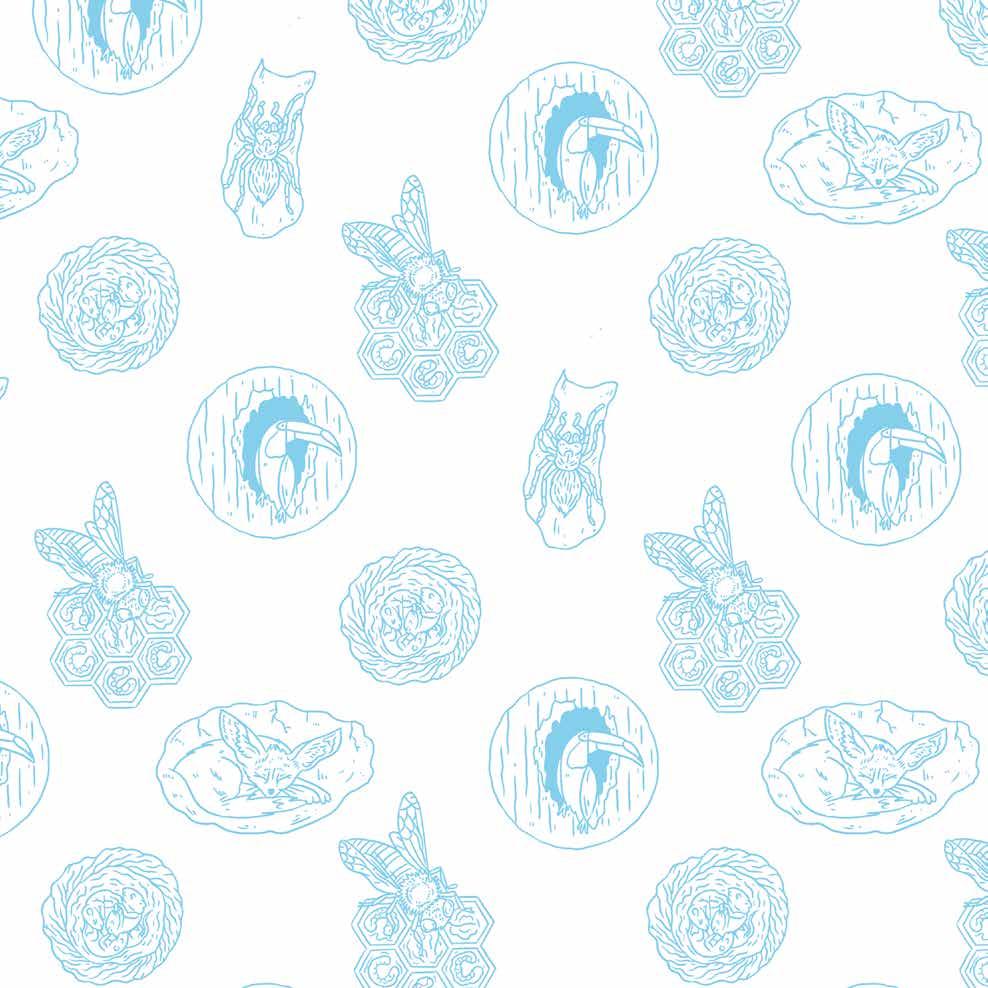MARVELOUS
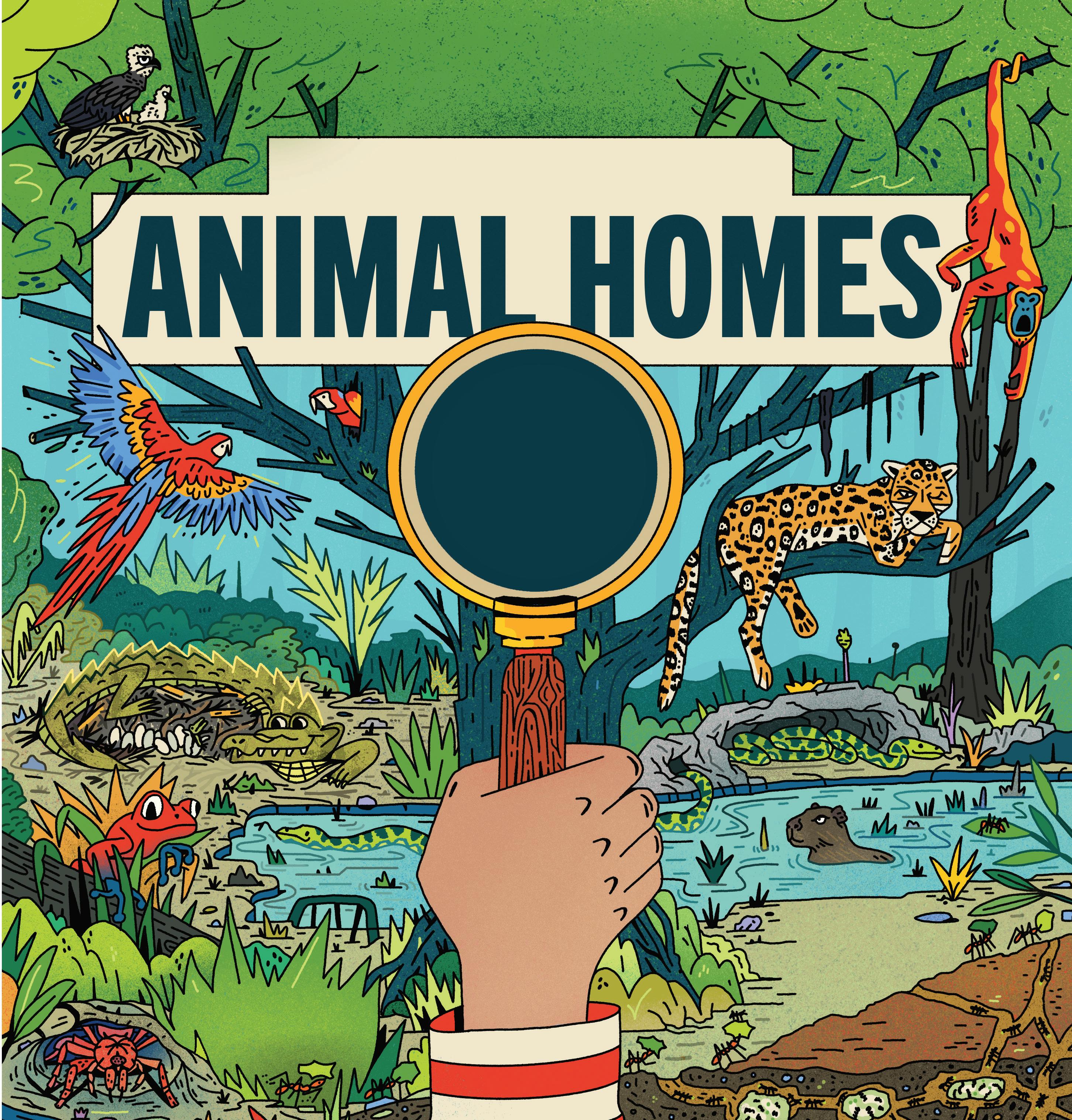
INSIDEANIMALHOMES
S E E
A MAGICLENS
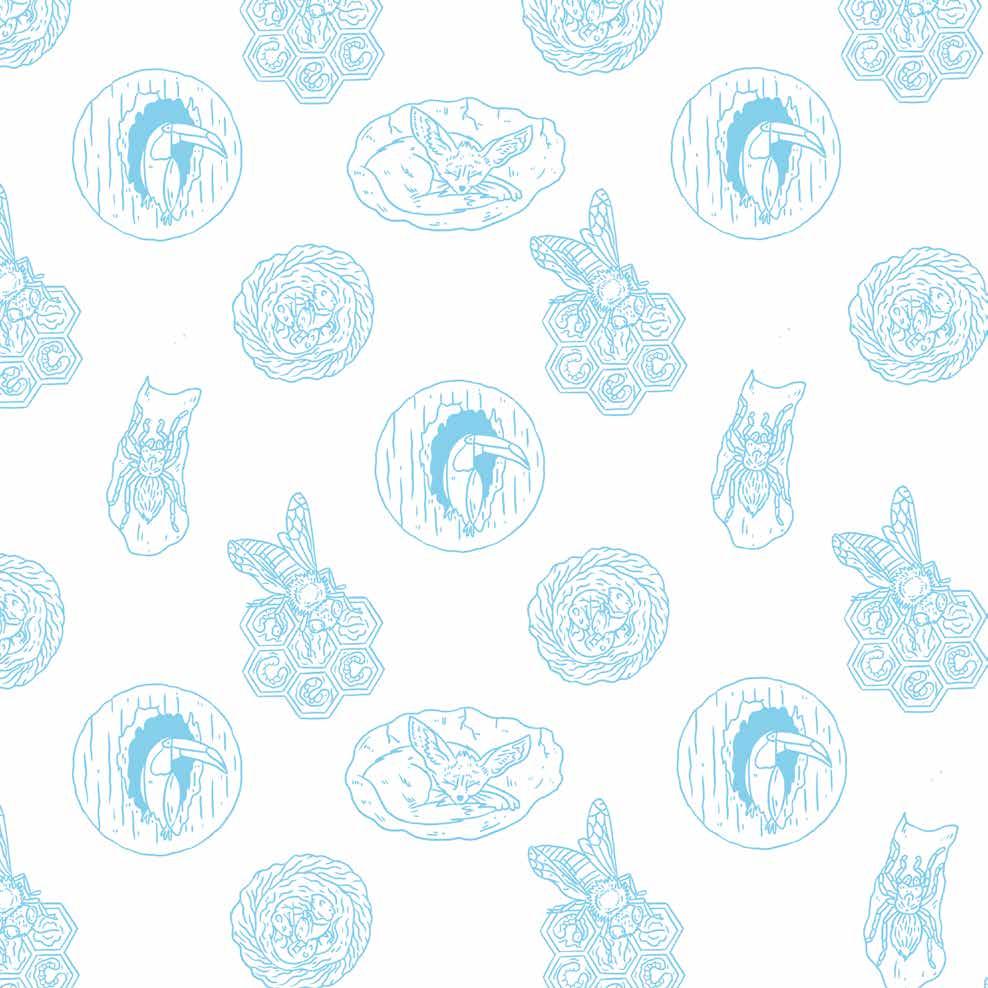


S E E

By Jane Wilsher
What on Earth! is an imprint of What on Earth Publishing
The Black Barn, Wickhurst Farm, Leigh, Tonbridge, Kent, UK, TN11 8PS
30 Ridge Road Unit B, Greenbelt, Maryland, 20770, United States
First published in the United States in 2025
Text by Jane Wilsher © 2025 What on Earth Publishing Ltd
Illustrations by Laurie Avon © 2025 What on Earth Publishing Ltd
Designed by Andrew Mansfield Consultant: Barbara Taylor
All rights reserved. No part of this publication may be reproduced or transmitted in any form or by any means, electronic or mechanical, including photocopying, recording, or any information storage or retrieval system, without permission in writing from the publishers. Requests for permission to make copies of any part of this work should be directed to contactus@whatonearthbooks.com.
Staff for this book: Nancy Feresten, Managing Director; Natalie Bellos, Publisher; Sue Grabham, Editorial Consultant; Katy Lennon, Senior Editor; Andy Forshaw, Art Director; Vanessa Bird, Indexer; Elizabeth Fletcher, Proofreader; Sian Smith, Production Manager
Library of Congress Cataloging-in-Publication Data available upon request
ISBN: 9781804661482
Printed in China
DC/Shenzhen, China/05/2025
10 9 8 7 6 5 4 3 2 1
whatonearthbooks.com
Home, sweet home
Snowy tundra
Grizzly bear den
Mountain high
Gorilla camp
Birds’ nests
Steamy rainforest
Leafcutter ants’ nest
At home in the trees
Hot desert
Termite mound
heat
This book comes with its very own magic lens, which reveals what’s going on inside nests, dens, hives, burrows, and other animal homes.
Whenever you see a red pattern, wave your magic lens over it to reveal what’s hidden. Why not try it on the bird’s nest picture below?
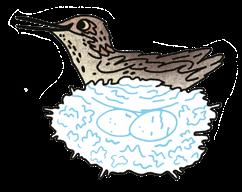
Can you see the eggs inside the nest? Try out the magic lens on all the pages in this book.


When you see the magic lens picture, use your lens to look at the red, patterned parts of the page and discover what’s inside the animal homes.
When you see a picture of an eye, try to spot everything on the numbered list. Some of them can be seen in the picture and others are hidden. You’ll need your magic lens to spot the hidden things!
What kinds of homes do different animals make?
What do animals do inside their homes?
Just like you, an animal eats, sleeps, and keeps safe inside its home.
An animal home may be as tiny as a humingbird’s nest or as huge as a bear’s den. A snail is born with a shell on its back, which is also its home. An elephant doesn’t have a fixed home but wanders across the vast lands where it lives. Different animals make very different kinds of homes.
Why do animals make homes?
Home is a place to keep dry and warm, or cool, depending on the weather outside.
An animal home can also be a safe place to lay eggs, look after babies, and shelter from danger. Many animals spend a great deal of their time trying not to be eaten by predators. A fox hunts a bird to eat, but the bird stays safely inside its home—a hole in a tree.
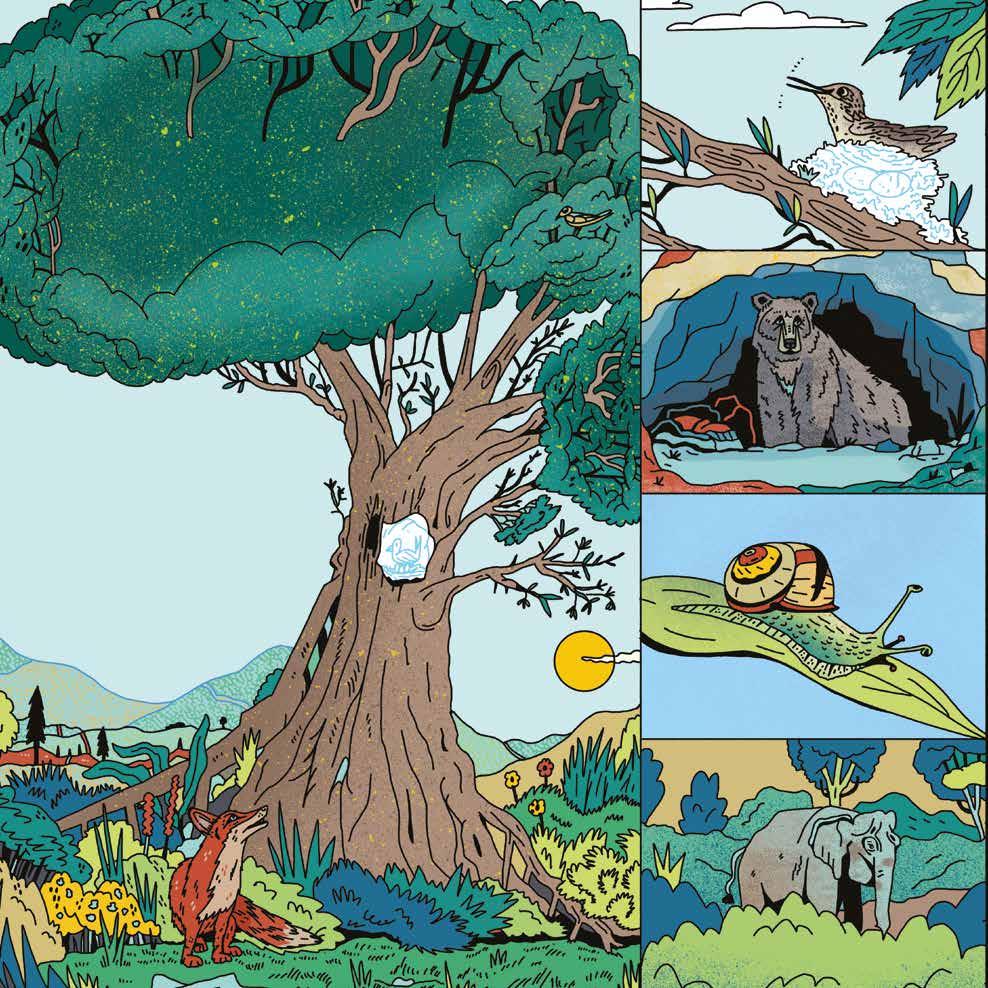
A predator is an animal that hunts other animals to eat.
Prey is an animal hunted by a predator.
How do Arctic animals make warm homes in the cold? Snow falls and fierce winds blow across this frozen land, called the polar tundra. Many animals build their homes under a blanket of snow or shelter out of the wind.
In the spring, all kinds of animals come out of their snowy dens. The weather is warmer, the days are longer, and a few shoots begin to show. It’s time to search for food and make nests for new babies.

Can you spot the animals on this list? You’ll need the magic lens to find some of them!
Arctic fox Arctic hare lemmings
eider ducks wolverine snowy owls
polar bear cubs
Arctic ground squirrel
A female Arctic hare lines her stony shelter with moss and fur to make a cozy nest. Soon, she will give birth to a litter of up to eight baby hares, called leverets.
On a hillside, an Arctic fox hides out of the wind in a burrow, or hole. The fox curls its tail around its body to keep warm. The Arctic fox’s coat changes color to blend in with its Arctic home. In winter, the coat is white as snow. In spring, it’s speckled like the rocky tundra.
6
All winter long, a group of lemmings crowd into a burrow with tunnels. Above, a layer of snow keeps the warmth inside their home. The lemmings eat roots growing down from the surface. In the spring, the lemmings come aboveground to eat fresh buds and leaves.
A pair of eider ducks soar over the tundra. They’re looking for a safe place to make a nest, somewhere hidden from predators. The female lines the nest with soft, downy feathers from her chest. This will help to keep her newborn chicks warm.
An Arctic ground squirrel pops up from its underground home, where it spent all winter. Straightaway, it starts preparing for its sleep, or hibernation, next winter by fattening up on spring grasses and fruits.
A couple of snowy owls make a nest on the cold ground. They build out of the wind so snow won’t blow inside the nest. The female scrapes at the rocks, presses the nest with her body, and adds a layer of feathers. Then she sits on her eggs.
A wolverine walks away from her snowy den under a heap of large rocks. She has given birth to two babies, called kits. Now she’s hungry! Large paws, long claws, and sharp teeth help her to hunt hares and ground squirrels on the snowy plains. She takes some of this food back to the den and buries some to eat later.
In the middle of the Arctic winter, polar bear cubs are born in a cozy, sheltered den. It is biting cold outside. The newborns are tiny, toothless, and blind, with just a thin layer of fur. But the den is safe and warm. Here, the mother feeds her cubs until spring, when they will be big and strong enough to go outside in search of food.
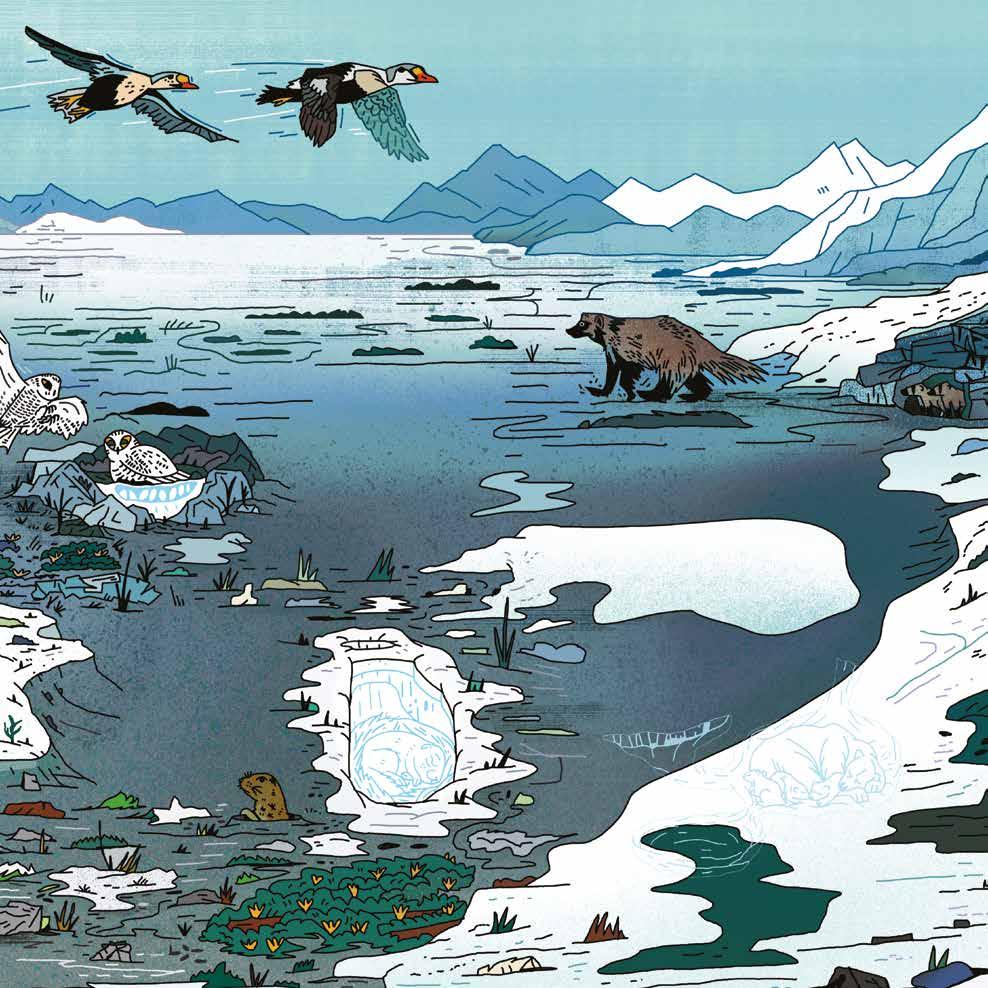
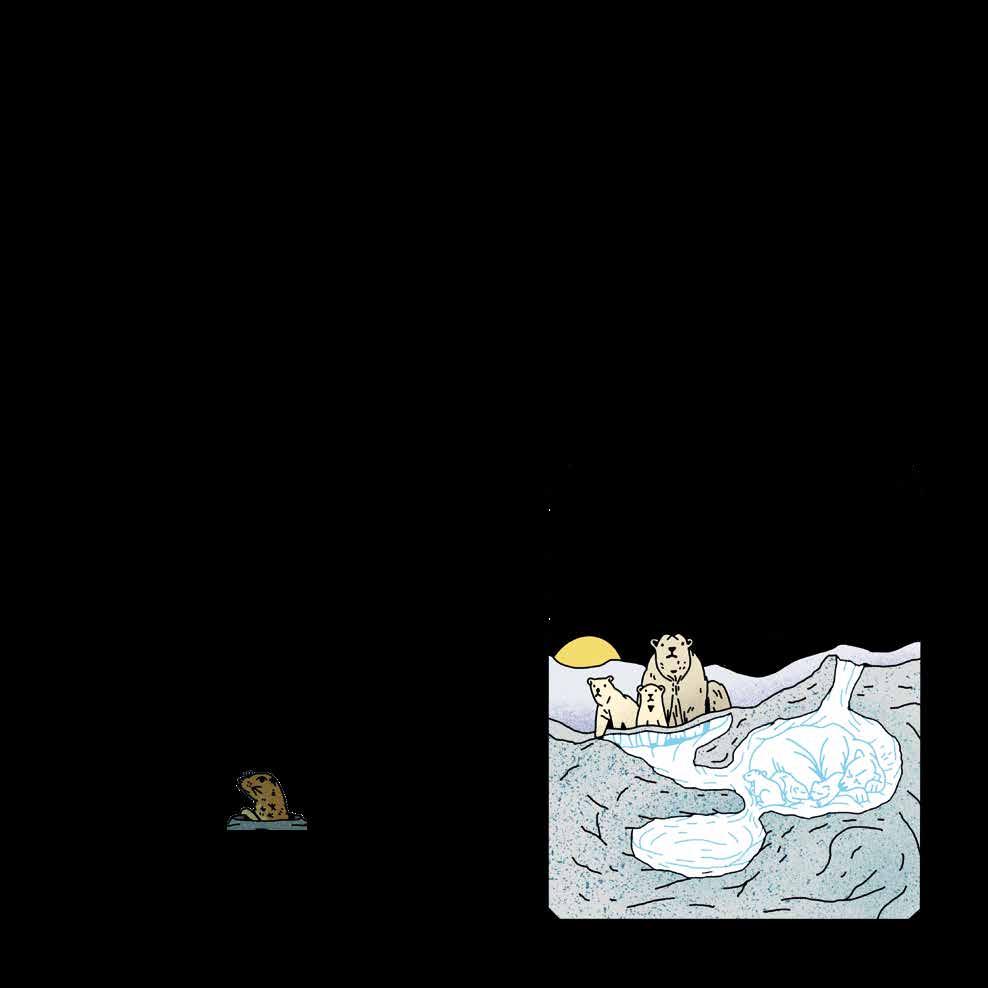

In winter, a thick layer of snow covers the den. The sleeping grizzly is inside. Its heartbeat and breathing slow down.

Can you spot everything on this list? You’ll need the magic lens to find some of them!
Often, a female bear might wake up and give birth to a couple of bear cubs Each is about the size of a teacup. They have no teeth and are blind for the first few days. The mother feeds them her rich, fatty milk. Everyone falls back to sleep.
In spring, as the snow is melting, the bear family wakes up and leaves the den. The bear cubs are strong and healthy. The cubs live with their mother for up to three years, until they are ready to look after themselves and build their own dens.
Discover what’s inside the grizzly bear’s den. LOOK INSIDE
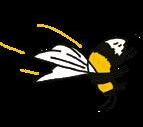
7
The Himalayan bumblebee is unusual, as it is rare for bees to live so high up. The Himalayan bumblebee drinks from rhododendron flowers on the lower slopes, then builds a hive under a cliff higher up the mountain.
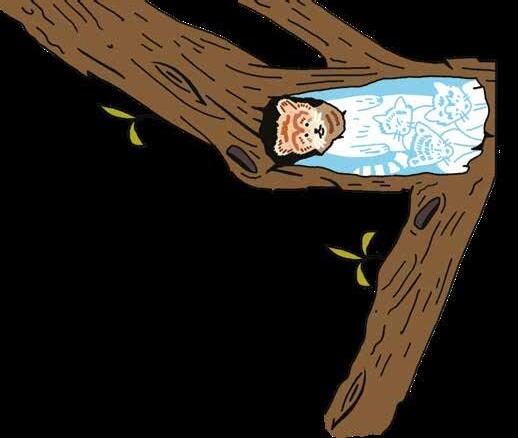
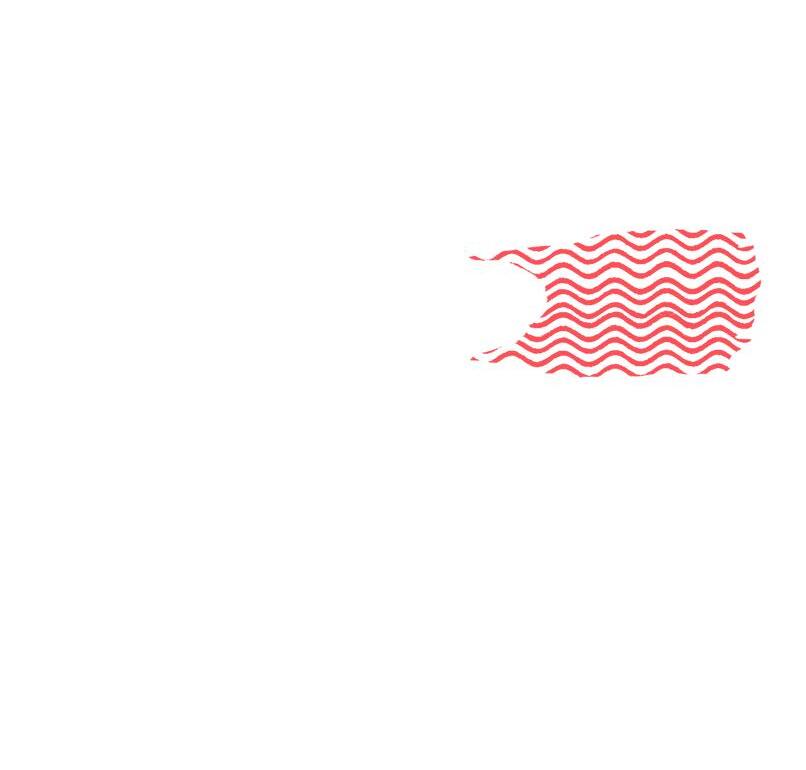
Musk deer live on the forested slopes of the mountain where they can hide from enemies. A deer’s fur coat looks short but it is thick and warm, with hairs that trap body heat.
Marmots live in burrows that have been passed down from family to family. Long tunnels lead to a den, where the whole family will sleep until the spring.
The Himalayan pit viper is a record-breaker. This snake is the highest-living snake in the world. During the day, the viper sleeps under rocks, stones, and leaves. At night, it slithers out to hunt millipedes and mice.
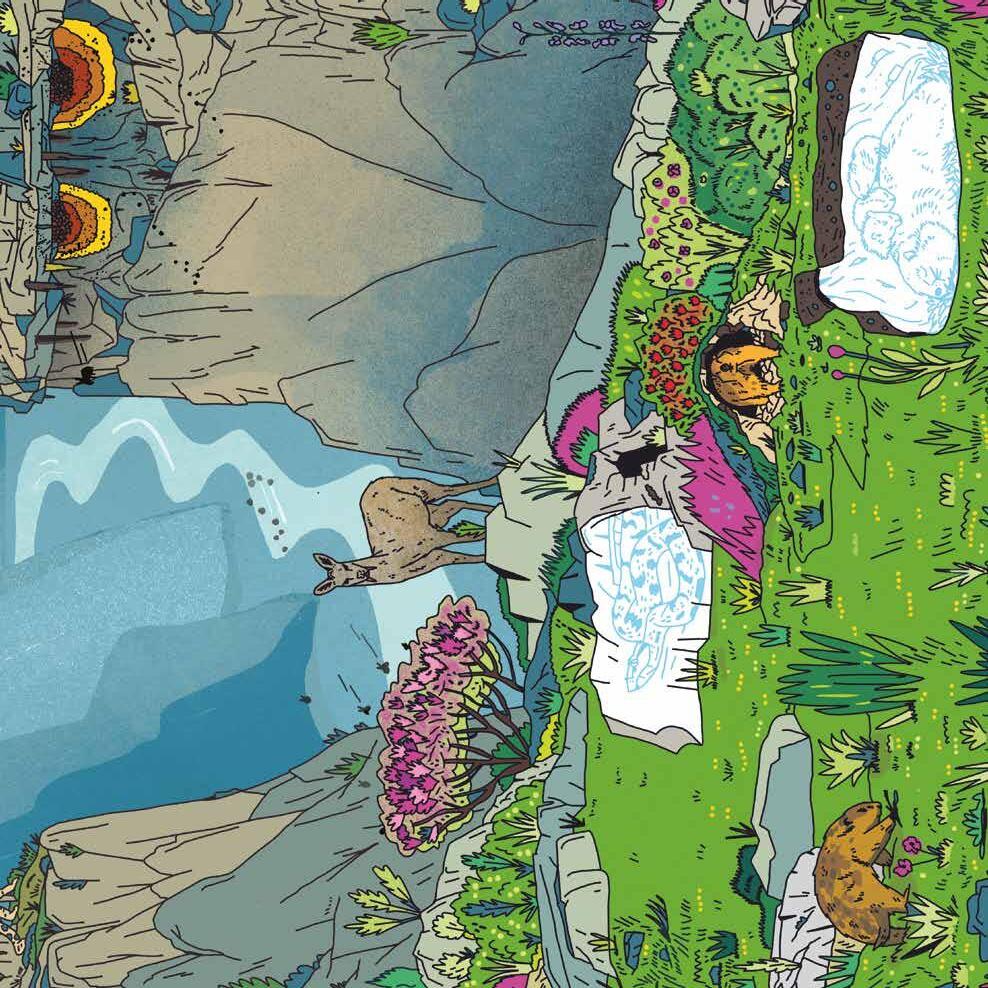

How often does a mountain gorilla make its own bed?
Every day, mountain gorillas find a new place to set up a camp. Every night, each adult gorilla makes itself a new bed, or nest.
Mountain gorillas live in the swirling mists of tropical forests in East Central Africa. A group of mountain gorillas, called a troop, roam across the forest looking for fresh plants to eat.

FIND IT
Can you spot everything on this list? You’ll need the magic lens to find some of them!
silverback
opposable thumb
nighttime nest
It’s sunrise, which means it’s breakfast time. A troop of mountain gorillas wake up in their camp. They are surrounded by plants to eat, including stems, leaves, berries, fruit, and tree bark.
One older male is in charge. He’s called a silverback because he has silver fur on his back. Each morning, he decides when to move off and find a new camp.
Gorillas are related to humans and, just like us, have opposable thumbs that move and grip. A mountain gorilla picks up plants to eat with its hands and fingers. It also uses them to help build its nest.
The mountain gorillas find a clearing where their favorite plants grow—bamboo and wild celery. In no time at all, the adults start building day nests, where they will doze for most of the afternoon. It takes a gorilla about five minutes to build its nest from layers of branches and soft leaves.

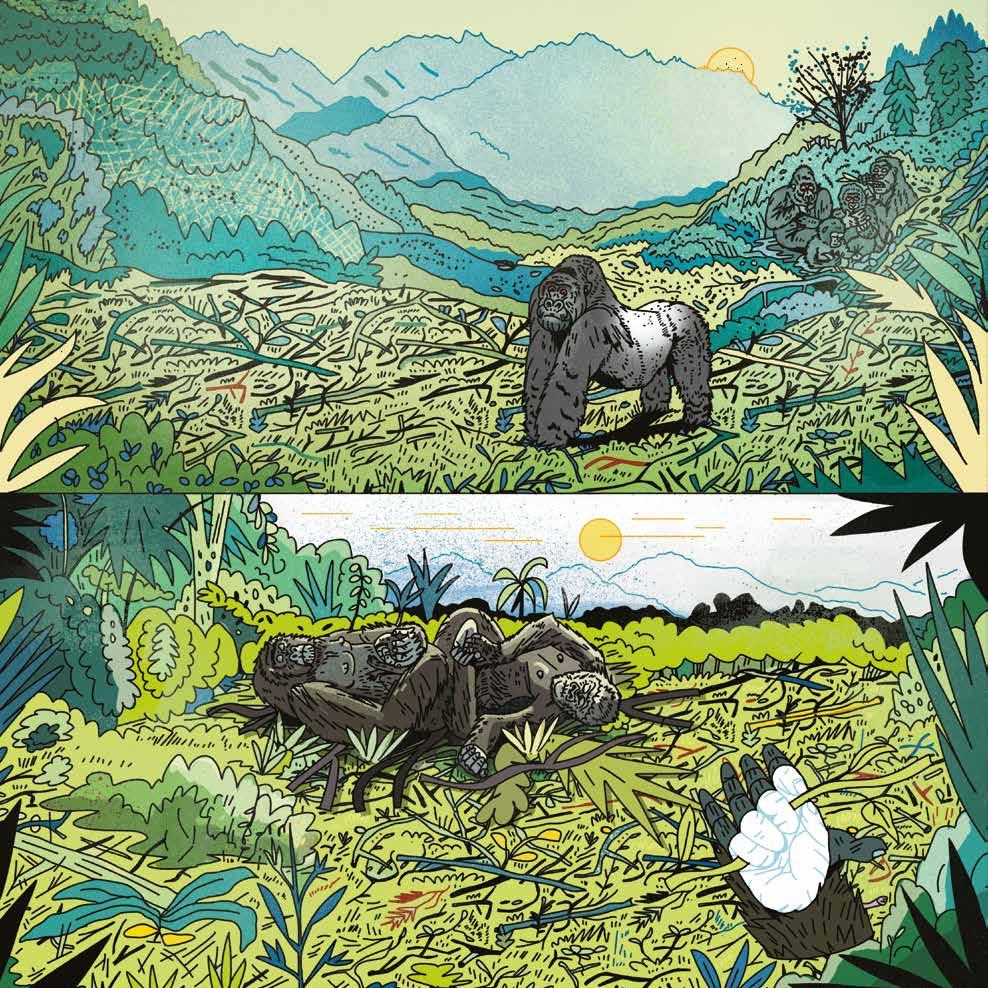
When the sun begins to set, it’s time for bed. Before it grows dark, each adult gorilla makes a nighttime nest. First, a gorilla finds a hollow in the ground, then layers up branches and leaves to make a soft, circular mattress. It’s a bit like a sleeping bag made from soft plants.
Find out where the mountain gorillas make their nests in the forest.

A young gorilla, called an infant, snuggles up to its mother in her warm nest. The infant learns from its mother how to build a nest. When the infant is about three years old, it will build its own comfy bed.
Some female mountain gorillas sleep in nests low in the trees. To build a tree nest, a female snaps off a few branches, then weaves them together into a platform. On top, she piles up twigs and leaves to make a soft cushion. Then she stretches out on her bed for the night.
Why do birds build nests?
A nest is a safe, comfy place where birds can lay their eggs and look after their young chicks.
Look up to see birds’ nests on cliff ledges and in the treetops. Many birds build their nests up high, out of the way of predators. From here, they can also look down and spot food to eat below.
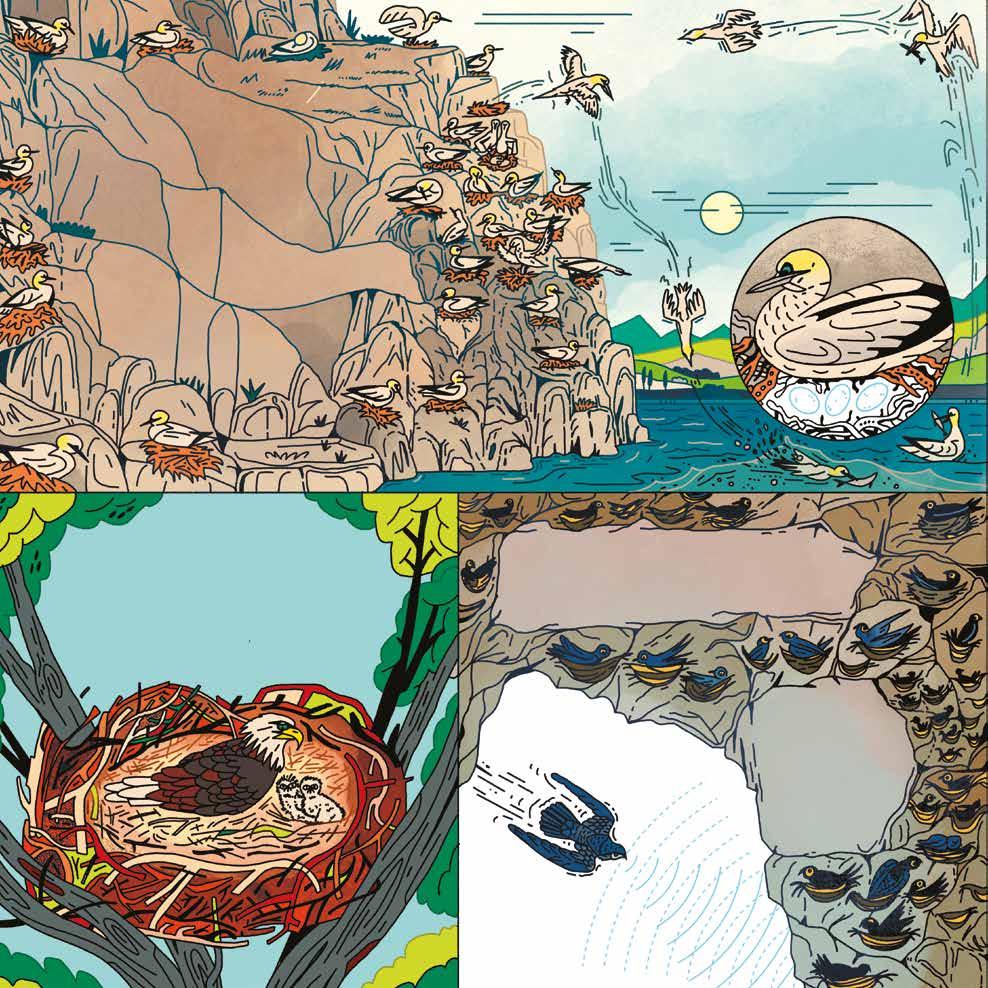
Why do gannets build their nests by the sea?
Gannets nest on cliffs, safely away from predators. Nests are made from mud, plants, and poo, which helps to hold the nest together. Many gannets nest together in a huge, noisy group called a colony. They dive into the sea to catch fish.
Which bird builds the biggest nest in the world?
A bald eagle’s nest can be up to 8 feet across—that’s roughly the same as two seven-year-olds lying head to toe. Year after year, the same pair of eagles might return to the nest. They repair it and patch it up with fresh twigs, so it’s as good as new.
How many swiftlets build their nests in a cave?
One inky-dark cave can be packed with thousands of swiftlet nests. Each pair of birds build their nest flat against the cave wall from gloopy spit that dries hard.
To help find its way in the dark, a swiftlet judges how far away things are by making a clicking sound, then waiting for the sound to bounce back.
Why does a peregrine falcon nest on a tall building?
To a peregrine falcon, a high city building is similar to a cliff ledge. The female chooses a spot to build a nest, then scrapes a shallow dip and lays her eggs. Often the nest can be seen by predatory birds, so a peregrine falcon might need to fight in midair to keep the eggs and chicks safe.
Why is this bird called a red oven bird?
It was named after the shape of its nest, which looks like a traditional mud oven in South America, where it lives. A female oven bird builds a nest with the entrance on one side, so predators can’t see the nest from above.
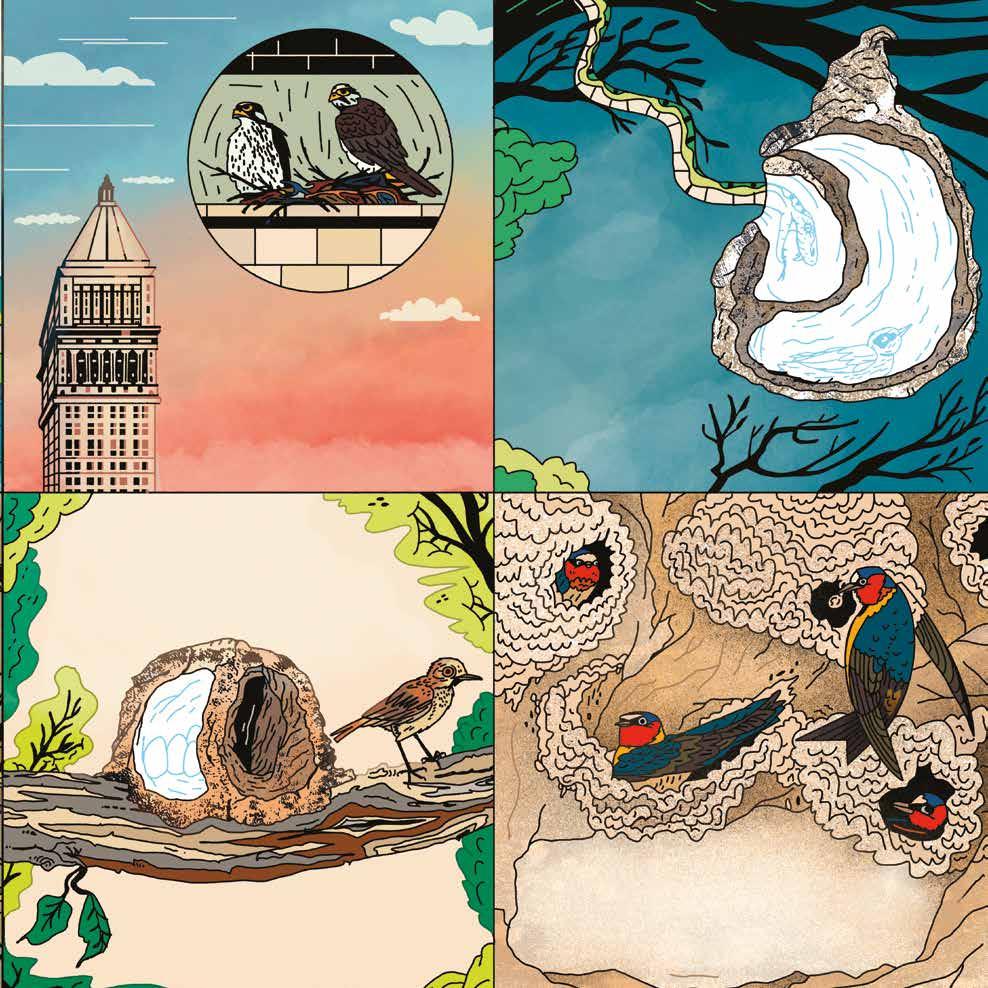
Why is the penduline tit’s nest a clever trick?
The penduline tit builds a nest with two openings— a real, secret entrance and a false one. If predators find the nest, they are likely to go into the false entrance, find nothing, and leave.

See how different types of birds build their nests in
How does a pair of cliff swallows build their nest?
A hardworking pair of cliff swallows build a nest with more than one thousand pellets of mud. Each bird takes a mouthful of mud in its beak, then mixes it with spit. Pellet by pellet, they build a clay nest that dries hard. Soon, their cup-shaped nest hangs under a cliff ledge.
Where do animals make their homes in the hot and wet Amazon rainforest?
Everywhere—from the tops of the trees to the forest floor. More than three million different kinds of animals live here.
The sun shines and the rain pours down. Birds build nests in the high branches, while lower down, monkeys, bats, and frogs shelter under a patchwork of leaves. On the forest floor, insects scuttle among the damp bark and tangled roots.
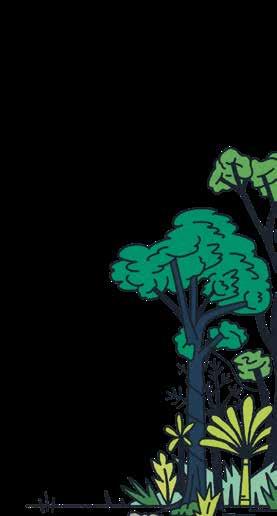
A rainforest tree can grow as tall as a 20-story building. In the rainforest, there are different layers where different kinds of animals make their homes.
Emergent layer
Birds and butterflies soar in the sun-drenched treetops.
Canopy
Monkeys swing through the thick branches and birds peck at berries.
Understory
Snakes and bats live among the vines. A jaguar might hide here, too.
Forest floor
Who makes their home where? LOOK INSIDE
Here, many animals search for bugs and fallen fruit to eat.

The jaguar doesn’t have many predators so it makes all the understory its home. This big cat snoozes on a high branch with one eye open, ready to pounce and eat animals below.

Can you spot the animals on this list? You’ll need the magic lens to find some of them!
toucan chicks jaguar
red-eyed tree frog harpy eagles howler monkey
three-toed sloth tent-making bats caiman anaconda bugs, beetles, and spiders
A hollow tree makes a safe, hidden nest for toucan chicks. The chicks’ mother can poke her long bill, or beak, through the hole with fruit for them to eat.
Find the baby animals in their rainforest homes.

The red-eyed tree frog swims in its very own swimming pool home. First, it hides inside bromeliad leaves, which are shaped like a bowl. Then, when it rains, the bowl fills with water.
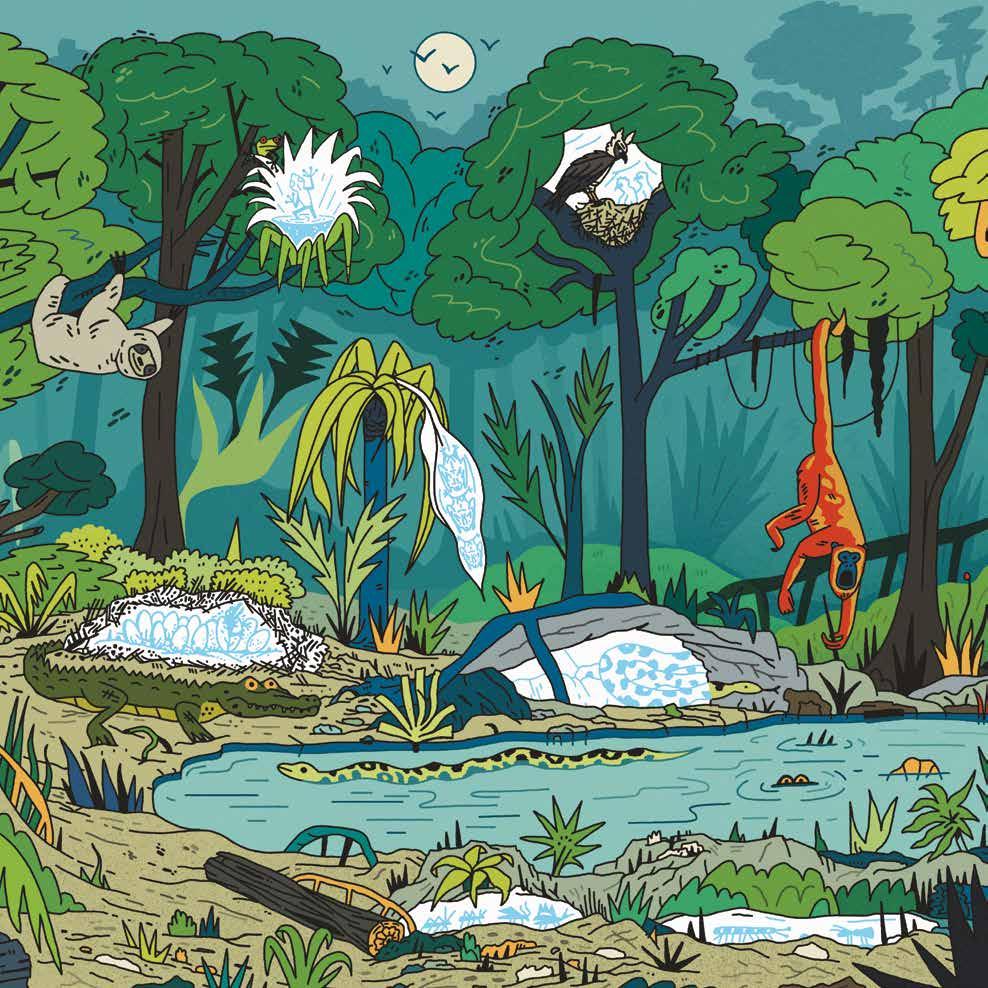
The three-toed sloth doesn’t need a nest. It holds on tight to a branch with long, curved claws, spending all day fast asleep, upside down.
Can you see the anaconda in the river? It’s harder to spot on land. This snake’s mottled skin blends into the colors of the forest floor.
Look up to the top of the tallest tree to see a huge nest built by a pair of harpy eagles
These birds dive, then grab animals below with their razor-sharp claws, called talons.
Near the river, a female caiman builds a nest from soil and leaves, then lays her eggs. When she hears one of her eggs hatch, she will carry the young camain to the water’s edge in her mouth.
Tent-making bats make a nest in the shape of a tent. The bats bite a leaf in its middle. This makes the leaf fold down into a tent shape. The tiny bats are now safe from predators, the rain, and the sun.
In the daytime, a howler monkey swings from tree to tree searching for fruit to eat. It hooks its tail over a branch, just like another arm. At night, the monkey beds down in a leafy nest, high in the treetops.
All kinds of bugs, beetles, and spiders make their homes in the dark corners of the forest floor. Many also live on the ridged bark of the trees.
Why do leafcutter ants carry giant leaves to their home?
Leafcutter ants hold leaves high above their heads and march along tree branches, then down to the forest floor.
The ants are on their way to their underground nest. Deep below the rainforest, the leafcutter ants use the leaves they have collected to help grow a special kind of food to eat—fungus. The leafcutter ants’ home is a fungus farm!
A leafcutter ants’ nest is called a colony. It can be home to up to 10 million ants. Leafcutter ants are social animals, which means they work together to build a home and find food. Each ant has an important job to do.
The maxima leafcutter ant is an explorer. Its job is to search for fresh leaves in the rainforest.
The media leafcutter ant is like a lumberjack. It cuts down the leaves with its powerful jaws Other media ants collect the fallen leaves.
Media leafcutter ants take the leaves back to the colony. They hold the leaves tightly in their mouths, high above their heads, like green flags.

What are the three sizes of leafcutter ant?
A maxima is the largest of the worker ants. As well as scouting for fresh leaves, it guards the colony.
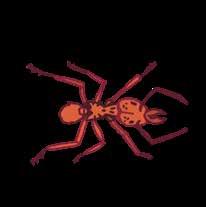
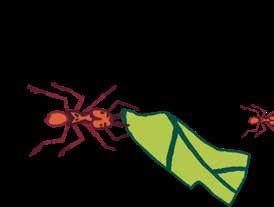
A media is a medium-sized worker ant. One type has a groove on its head to hold in place a leaf that can be 20 times heavier than the ant’s body. A minima is a small worker ant. It lives only underground, farming and looking after the young.

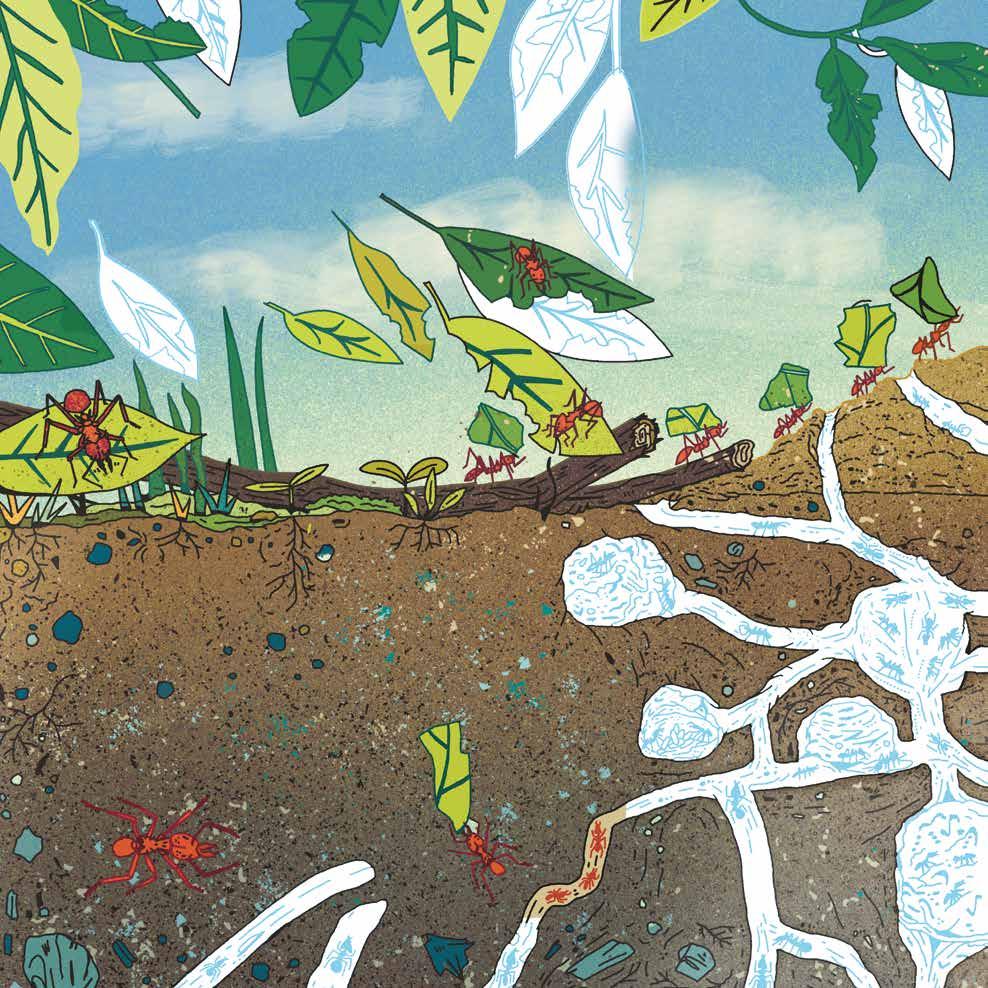
See what happens underground, deep inside a leafcutter ants’ nest.
In the colony, minima leafcutter ants are in charge. These farmer ants carefully look after the fungus farm.
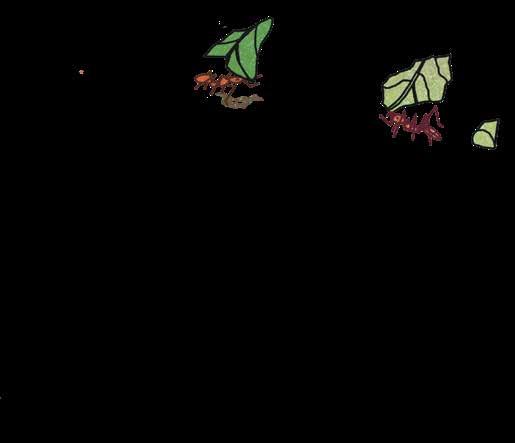
The minima leafcutter ants chew the leaves into mushy leaf pellets, which they place on top of a layer of fungus. The goodness in the rotting leaves feeds the fungus.
There are thousands of chambers in the nest. Some are growing chambers, where fresh and older fungi grow. There’s even a chamber for trash.
Young
ants,
larvae grow
adults and the
FIND IT
Can you spot everything on this list? You’ll need the magic lens to find some of them!
colony
maxima leafcutter ant
powerful jaws
media leafcutter ants
minima leafcutter ants
leaf pellets
growing chambers
nursery chamber
larvae
queen
The queen has her own chamber. She is the most important ant in the colony because she is the only one who can lay eggs. A queen can lay more than 25,000 eggs a day!
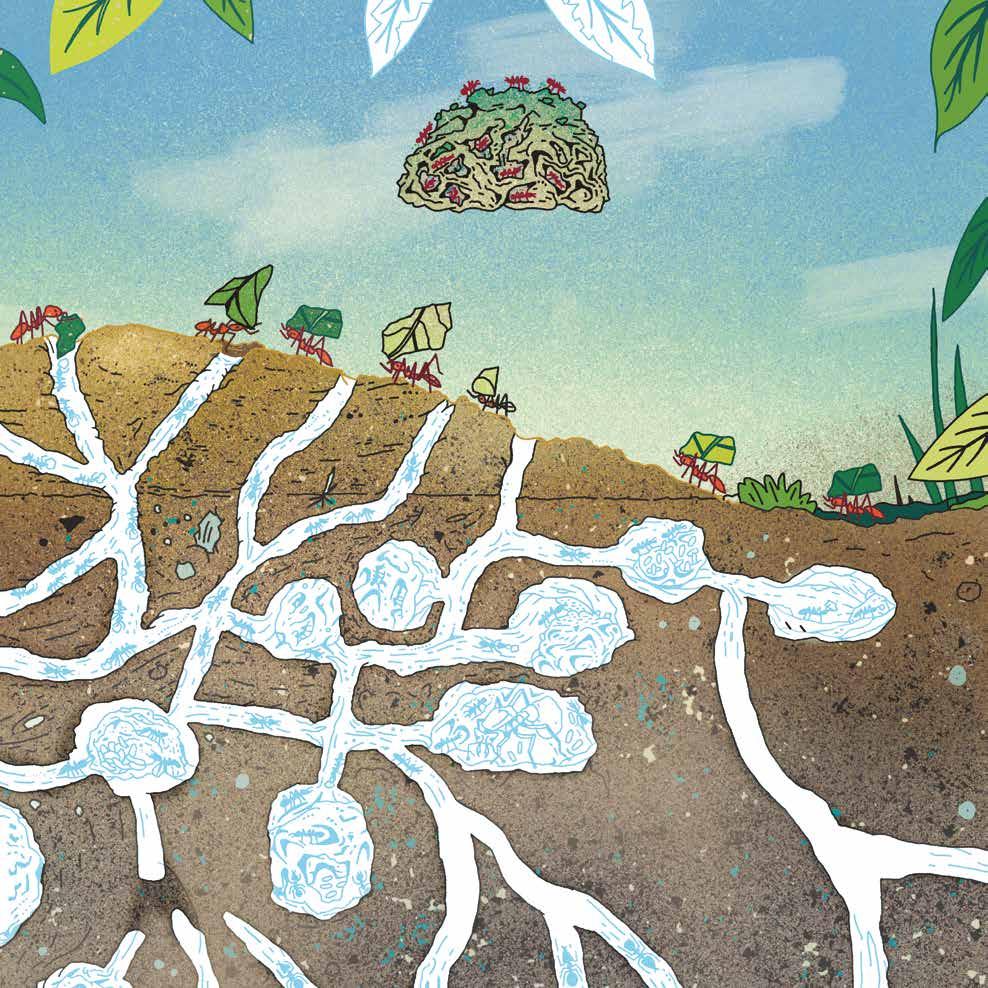
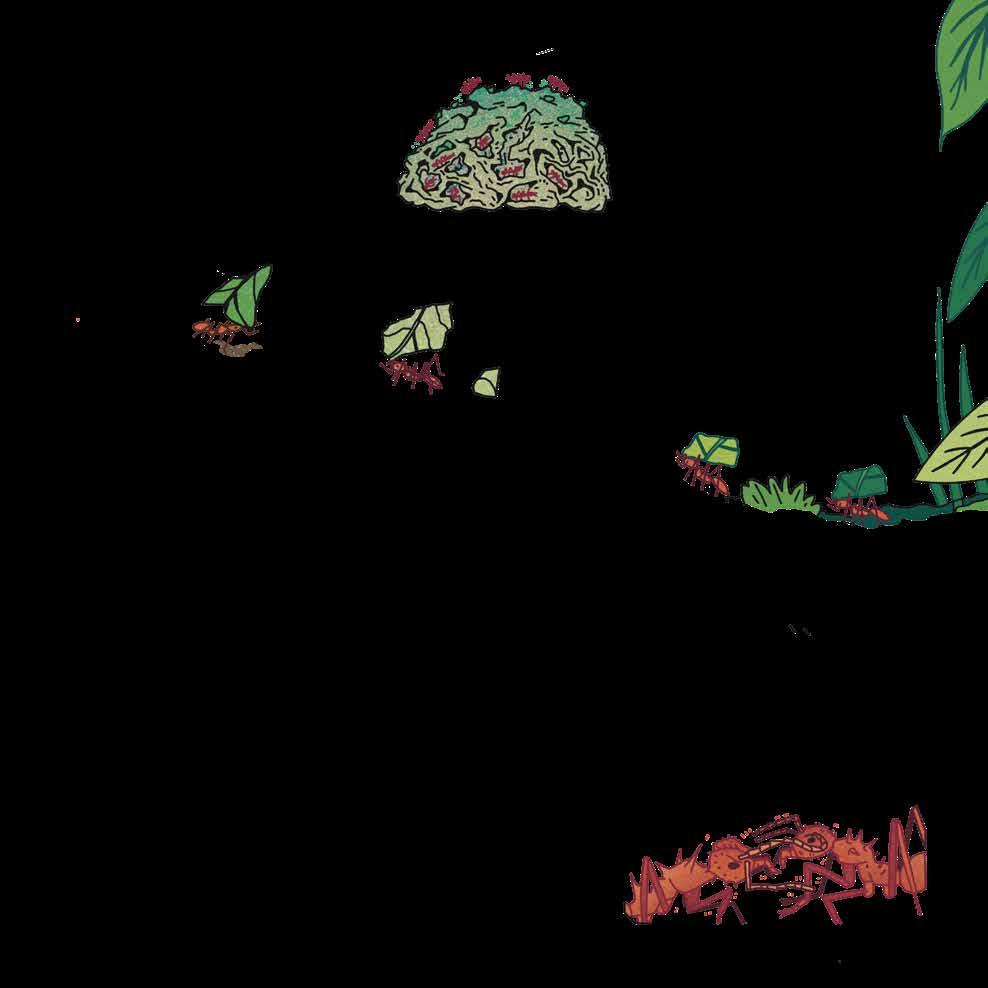
Where does a mother-to-be panda give birth?
In China, on a cold mountain, a female panda makes a nest in the hollow of a tree. She shreds bamboo plants into tiny pieces to make soft bedding. Then the panda gives birth to a cub, which is about the size of a pet cat’s kitten. The mother panda feeds the cub her milk until it’s old enough to eat bamboo.

How long does a young stag beetle live underground?
A young stag beetle is called a larva. A fat white larva can spend up to seven years beneath the soil, eating rotting and dead wood. Over time, it changes into an adult with jaws like deer antlers. An adult stag beetle lives aboveground, scuttling across the forest.
How do honeybees build a nest in a tree?
On the edge of a meadow, a group of wild honeybees work together to construct their nest in a tree.
Think of the cells of the honeycomb as cupboards that store different things. Inside some cells, there is honey, which the bees eat for energy. In other cells, there is pollen, which is a protein-rich plant dust that the bees eat too. In yet more cells, there are young bees, called larvae.
A bee makes beeswax in its body. Together, the honeybees build rows and rows of connected cells from their beeswax. This structure is called a honeycomb.

Peer into cactuses, caves, and burrows to see the desert-animal homes.

Each night, after a day’s hunting, a bobcat finds a new shelter. It might be a cave, a hollow log, or a rocky den. When a mother has babies, called kittens, she moves them around from shelter to shelter to keep them safe.
A big coyote family, called a pack, lives protected from predators and the weather in a large underground den. The top female stays to look after her pups. The top male and other members of the pack hunt and bring back food.
Often, a burrowing owl makes itself at home in the abandoned burrow of a prairie dog. When the owl is about to have chicks, she collects animal dung and scatters it in and around the burrow so dung beetles will visit. Then the owl and her chicks eat the beetles.
In a deep underground burrow, a tarantula keeps out of the heat of the sun and hides from predators. The tarantula digs its burrow with large fangs and powerful front legs. To stop sand and soil from falling into the hole, it spins silk to fortify the walls.

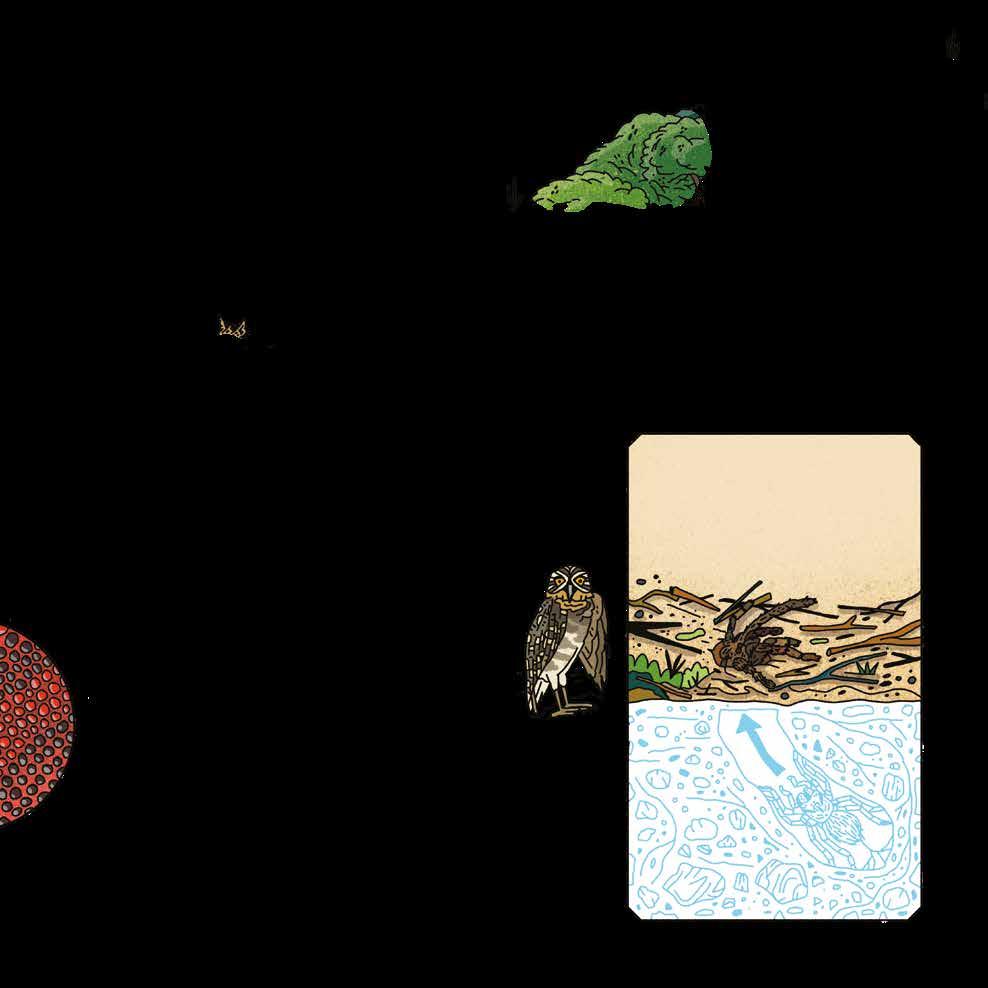
Fresh cool air sinks down the chimney to the underground living chambers .
These are the chambers where termites grow fungus Over time, the fungus becomes a rotten mush for the termites to eat. It helps them to digest wood, plants, and other food.
The queen lays about 25 eggs every minute. She might live and rule the mound for more than 25 years.
Worker termites have strong mandibles, which can chew through leaves, roots, and logs.
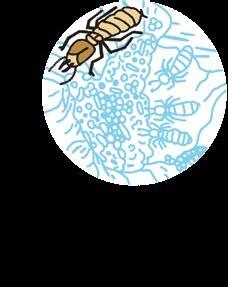
Young termites are looked after by the workers in the nursery .
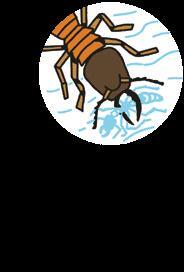
Soldier termites attack predators with their strong mandibles, or jaws.
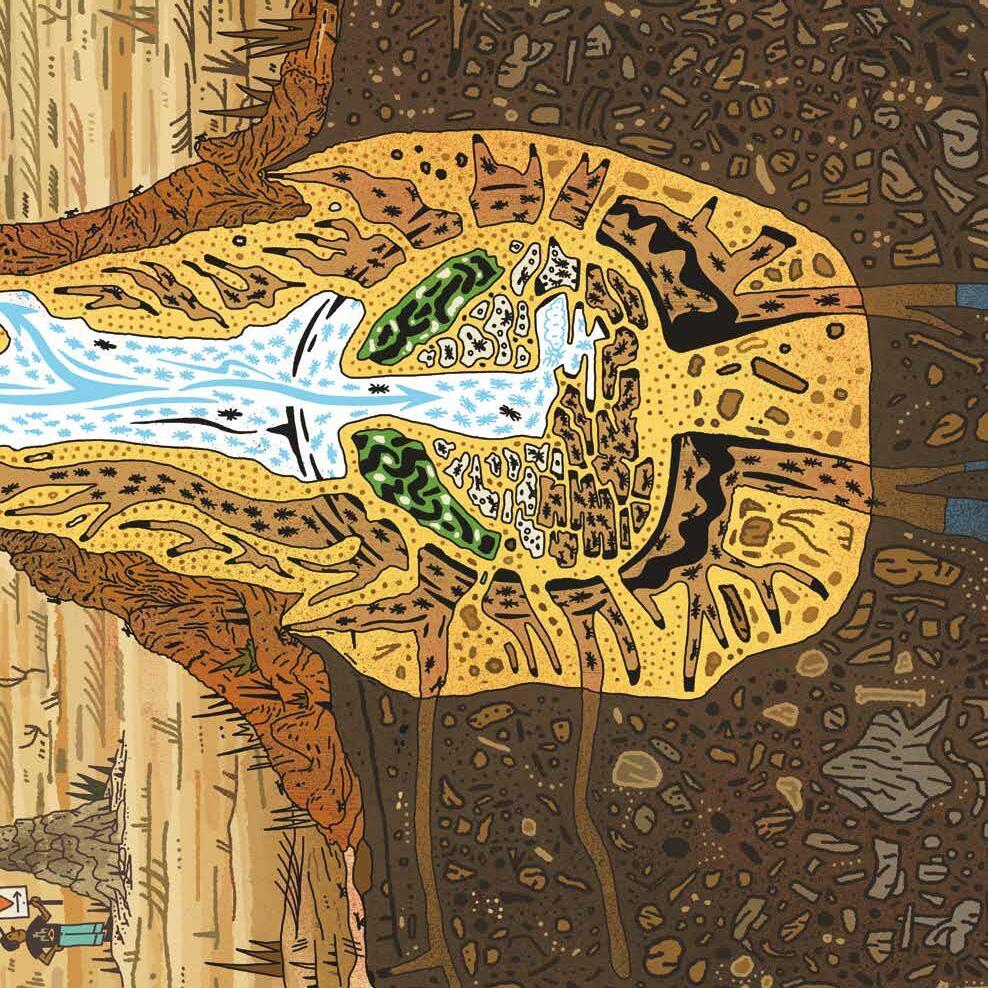
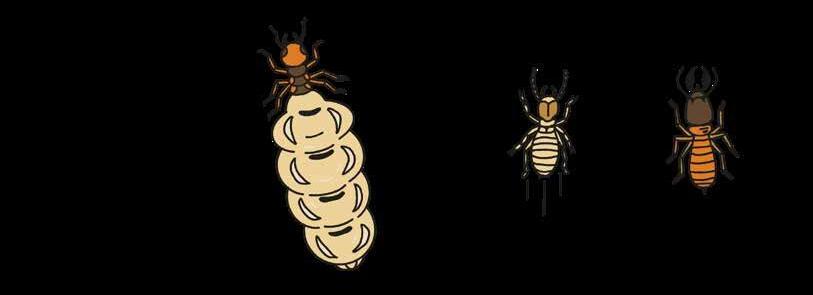
Royalty
The queen lays eggs that will grow into termites. She is 100 times bigger than the other termites and can live for up to 50 years!
Workers
The worker termites keep the queen clean and feed her fresh leaves. They look after the eggs, repair the nest, and help to grow the food.
Soldiers The soldier termites keep the queen and the young termites safe from predators. What jobs do different termites do?
How do animals make homes and keep cool in the hottest places?
Animals use ingenious ways to protect themselves from the burning sunshine.
For some animals, such as Indian harvester ants, jerboas, or great desert skinks, it’s a huge task to build a cool home. So, they work as a team. But a fennec fox and a Mojave tortoise dig an underground burrow for themselves. A kangaroo has a unique way of protecting its young in the extreme heat.
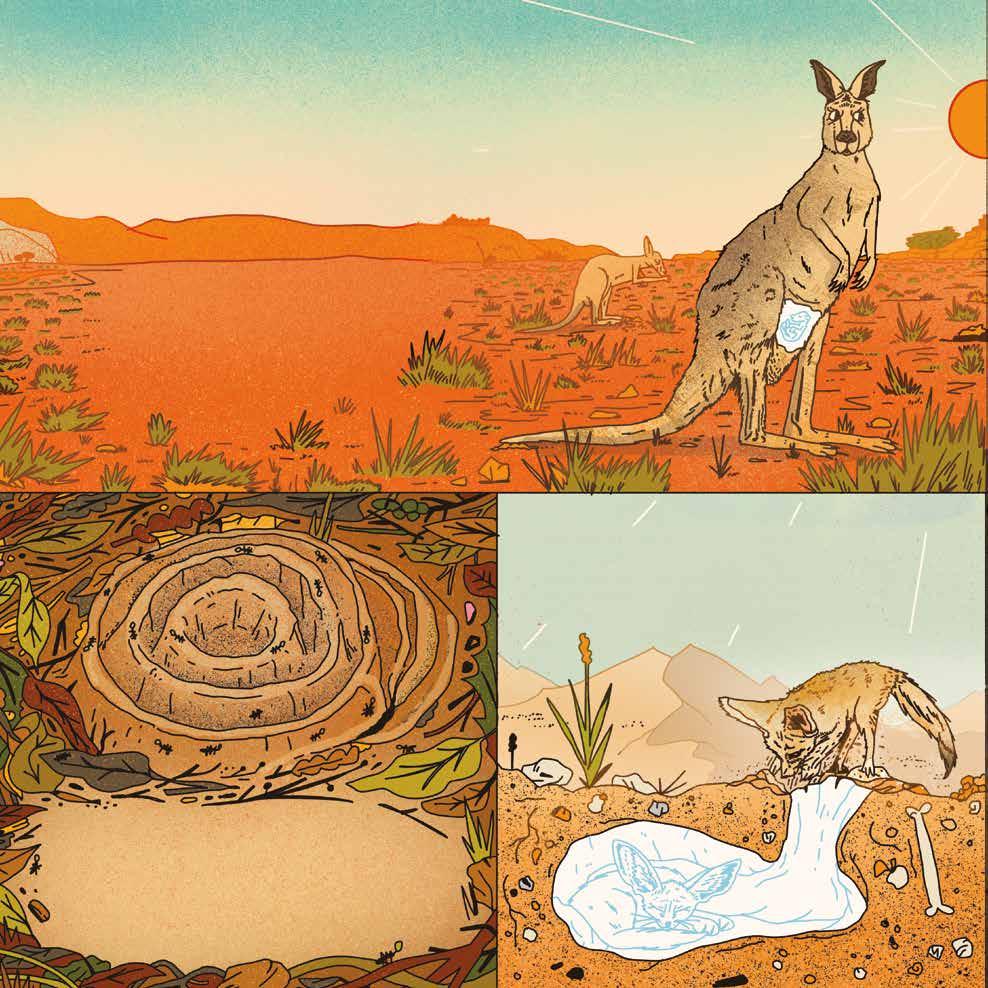
Why do Indian harvester ants build a round nest?
These ants have a clever way to keep themselves cool and dry. Aboveground, they build spiraling mud walls to stop their nest from flooding during heavy monsoon rains. The nests are built on a slant and the spiraling channels guide the rainwater away. Underground, the ants build tunnels with cool, narrow passageways to protect themselves from the beating, hot sun.
Where is a baby kangaroo kept safe?
In the Australian outback, a kangaroo mother provides a snug home for her baby, called a joey. She keeps her joey safe in a pouch of skin on her belly. When the joey is born, it’s the size of a jellybean. The joey drinks milk from its mother’s pouch until it is big and strong enough to live by itself.
How does a fennec fox use its furry feet to build its home?
In the Sahara Desert, a fennec fox uses its feet like shovels to dig a sandy, underground den. The fox’s feet are covered in thick fur and act like shoes so it can walk over the burning sand. The fox also has huge ears that give off heat and help to keep its body cool.
How does a tortoise avoid the heat of the desert?
A Mojave tortoise escapes the fierce heat of the sun in a cool underground burrow, where it spends most of its time. The tortoise is cold-blooded and so the same temperature as its surroundings. By sleeping through extremely hot periods in its underground burrow, the tortoise can survive on very little food.
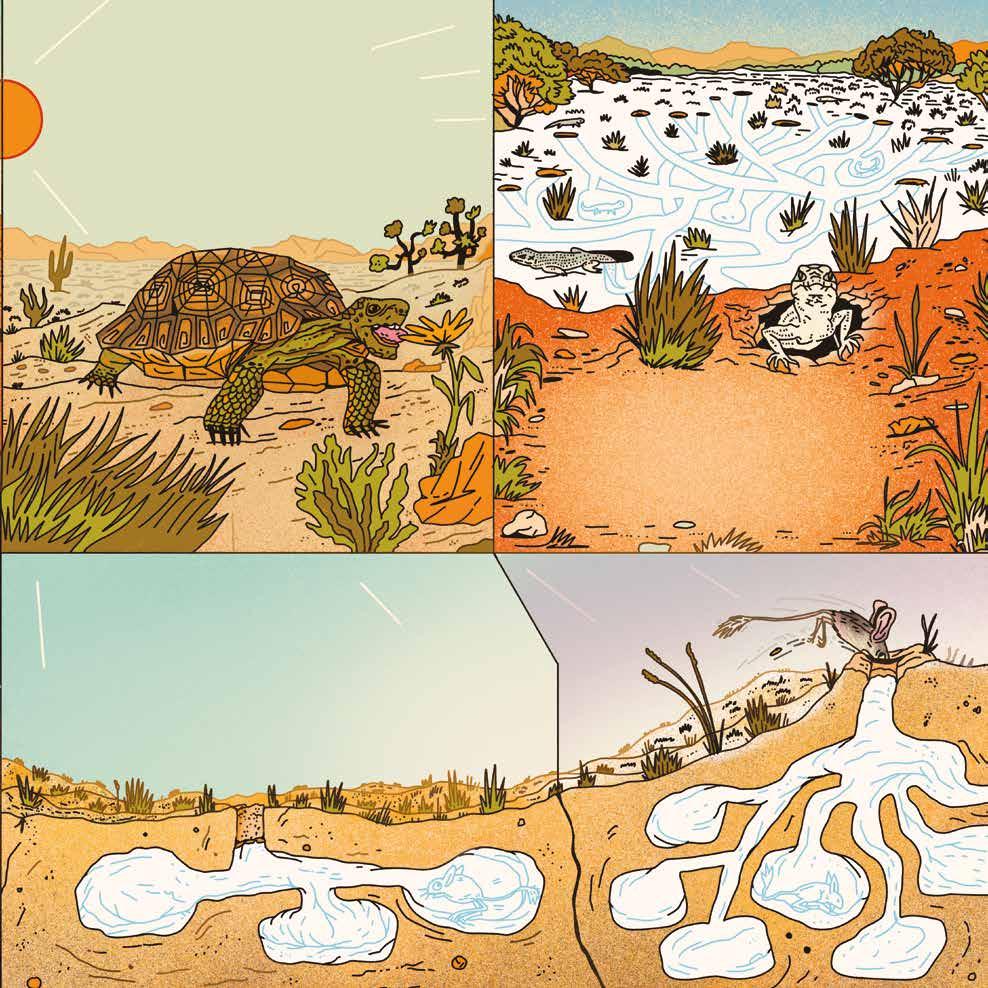
LOOK INSIDE
Find out how animals stay cool in the hot sun.

Which animal has more than one underground home?
Jerboas live in hot deserts and steppes, or dry grassy plains. They dig themselves many homes with their feet and teeth. To keep cool in the summer, a female digs a burrow close to the surface, where she looks after her pups. To stay warm in the winter, the jerboa digs another burrow, deeper underground. A jerboa might also build an away-day burrow, where it stays when out hunting.
What do great desert skinks build together?
Great desert skinks are burrowing lizards that live in the Australian desert. They work together to dig a huge underground home. There are rooms for adults, sharing rooms for brothers and sisters, plus a separate room where all the skinks can go to the toilet.
summer burrow
How do animals make their homes on grassy plains?
Flat, open grassy plains have different names in different places, including the savanna in Africa, the prairies in North America, and the outback in Australia.
Many grassland animals keep safe by digging underground burrows with their sharp claws or teeth. It can be difficult to spot grassland animals, who keep out of sight of hungry predators by blending in with the scrubby ground.
Who sleeps in its burrow for 16 hours a day?
On the South American grasslands, an armadillo digs a warm burrow with its long front claws. It sleeps for most of the day. Once in a while, an armadillo might share its burrow with a tortoise or a snake.
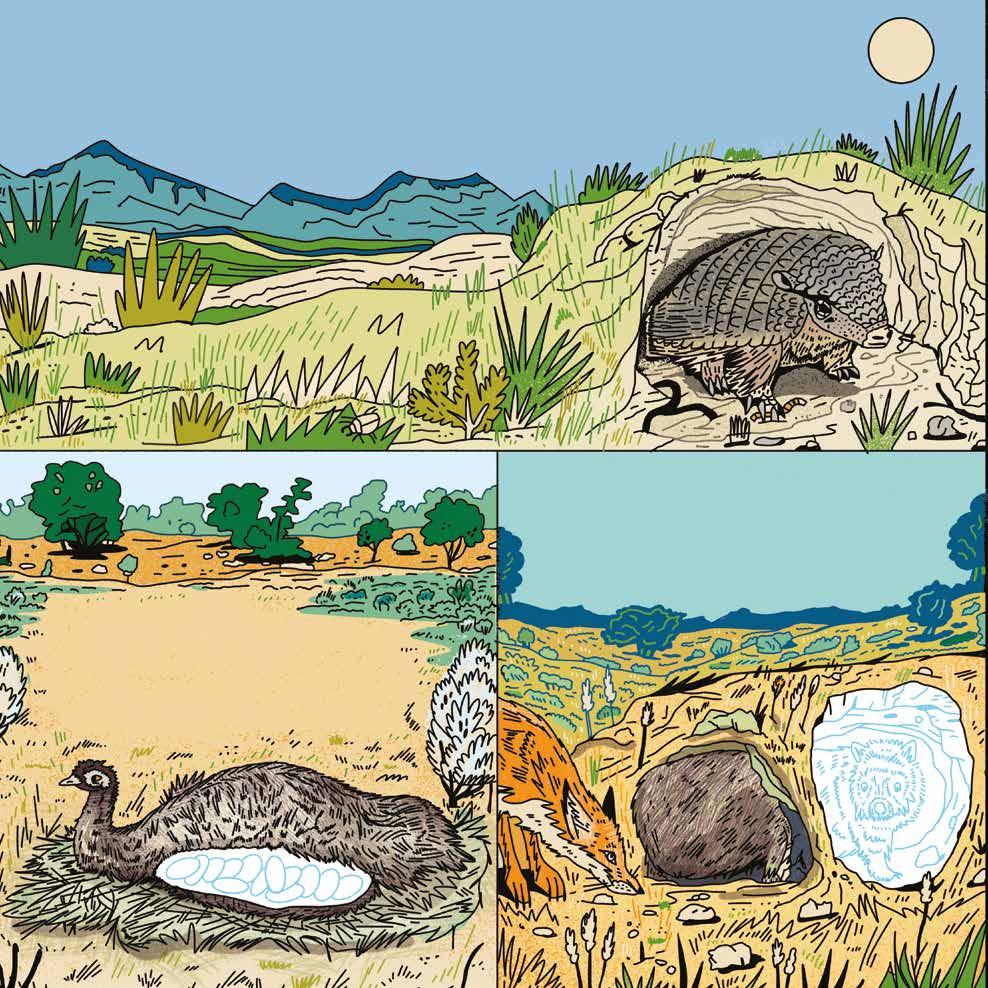
Where does an emu build its nest?
In the Australian outback, there aren’t many trees to make nests in, and an emu can’t fly anyway, so this bird makes a nest of twigs on the ground. The nest is bigger than a double bed and blends in with the reddish-brown soil. The male sits on the eggs to keep them warm so they will hatch. He also raises the chicks.
How does a wombat protect its burrow in the outback?
When a fox attacks a wombat’s burrow, the wombat has a quick way to keep safe. It plugs the entrance with its bottom, which is rock-hard and toughened with bone! The wombat also gives a hefty backward kick to stop the fox from coming too close.
How do prairie dogs keep safe on the plains?
On the flat North American plains, there’s nowhere to hide from predators, so prairie dogs dig burrows under the ground. Thousands of prairie dogs live in a network of tunnels, called a town. It can be as big as a human city aboveground!
To keep the whole town secure, prairie dogs use a clever language of barks to warn of danger. There are different kinds of barks for different predators, such as coyotes and black-footed ferrets.
In the daytime, it’s safe for the prairie dogs to come aboveground to eat grass. The short grass helps to make it easier to spot predators. The dogs’ light-brown fur blends into the dry grass and keeps them camouflaged.
Prairie dogs dig up to 70 deep holes and many connected tunnels with their long, sharp claws Prairie dogs look out for each other. They share their home and their food and live as a community.
Just like a town where people live, a prairie dog town has different neighborhoods. Several families live in a district called a ward. They greet each other by nuzzling their noses.
In the nursery, a mother prairie dog cares for her helpless newborn young, called pups. When the pups are about six weeks old, they venture aboveground. The pups learn how to keep safe there and belowground.
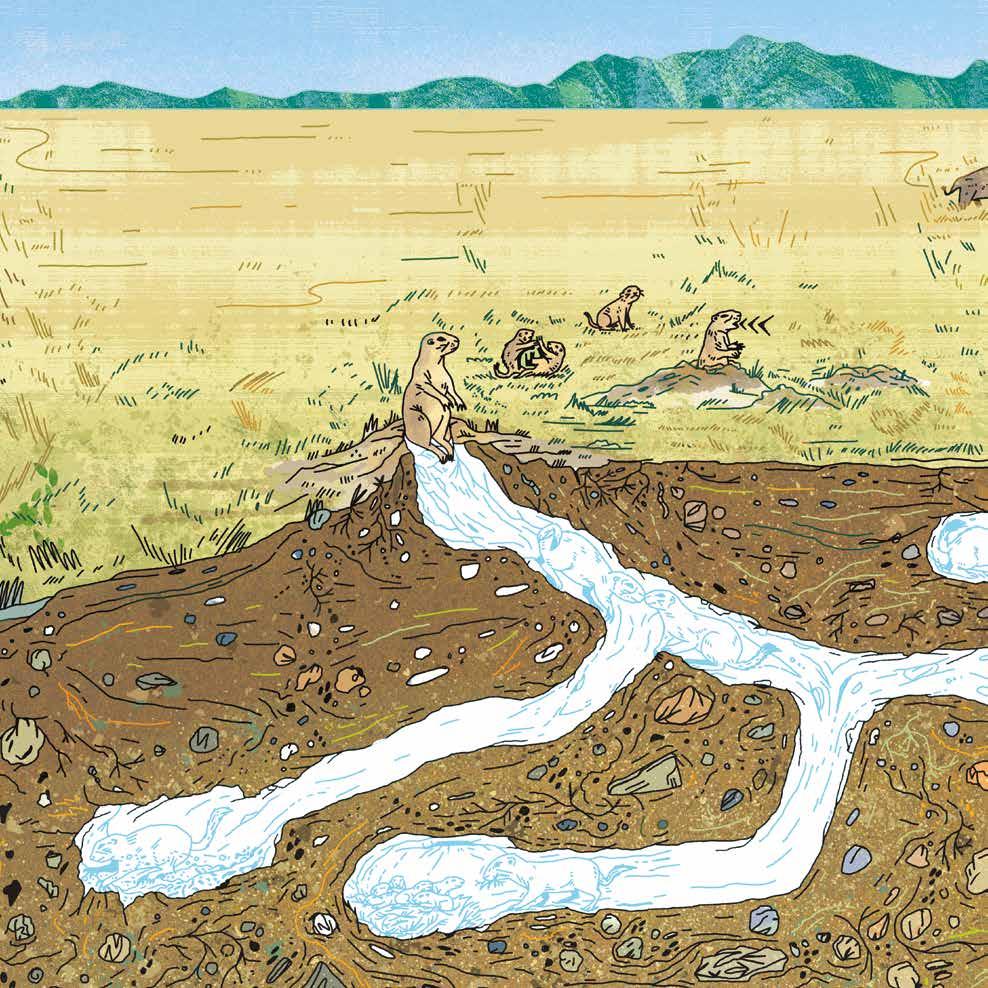
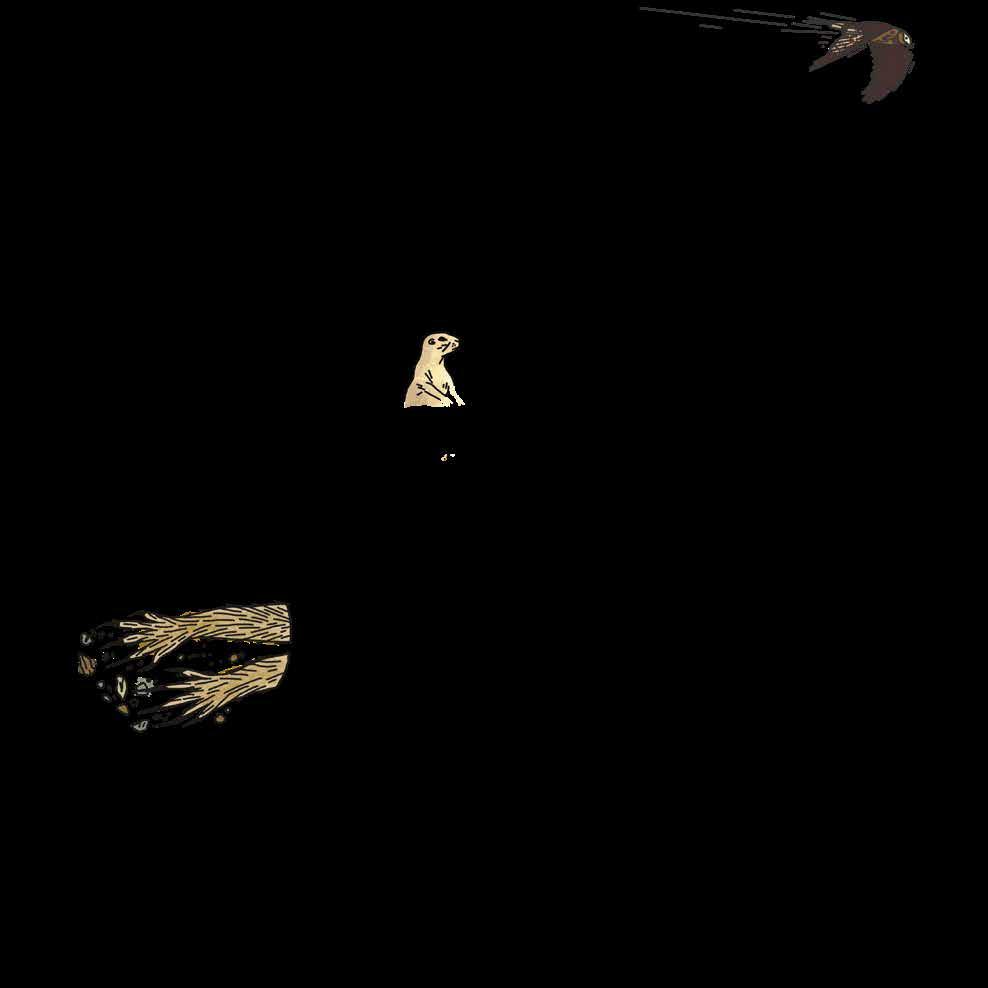
Do animals build homes on the African savanna?
Many animals don’t build homes here. A few animals do.
Zebras, hyenas, and other big savanna animals wander across the open plains, always on the move. A zebra roams, searching for fresh grass to eat. Meanwhile, a hyena is a meat-eating hunter that follows the zebra, looking for its next meal! A few smaller animals build underground homes, while birds make nests in the trees.
A pride of lions rest in the shade of a tree. Lions are at the top of the food chain, which means they won’t be attacked by other animals. They roam the plains, hunting animals to eat.

Can you spot the animals on this list? You’ll need the magic lens to find some of them!
pride of lions
hyenas
African rock python
ostrich
red-billed oxpecker
sociable weaver birds
warthog
African trapdoor spider
dung beetle
aardvark
There are only a few trees where animals can make their nests, so many smaller animals go underground.
The African rock python burrows a home into an old termite mound.
Discover who lives underground on the dusty African savanna. LOOK INSIDE

Hyenas operate as a team and hunt in a pack. When the hyenas have a clear view of a herd of zebras grazing, they circle, then try to pick off the weakest one. Together, hyenas can kill animals much bigger than themselves.
A female ostrich lays her eggs in a shallow hole in the sand. The male and female take turns to sit on the eggs to keep them safe and warm. Once in a while, the female turns the eggs with her beak to make sure they stay the same temperature all the way around.
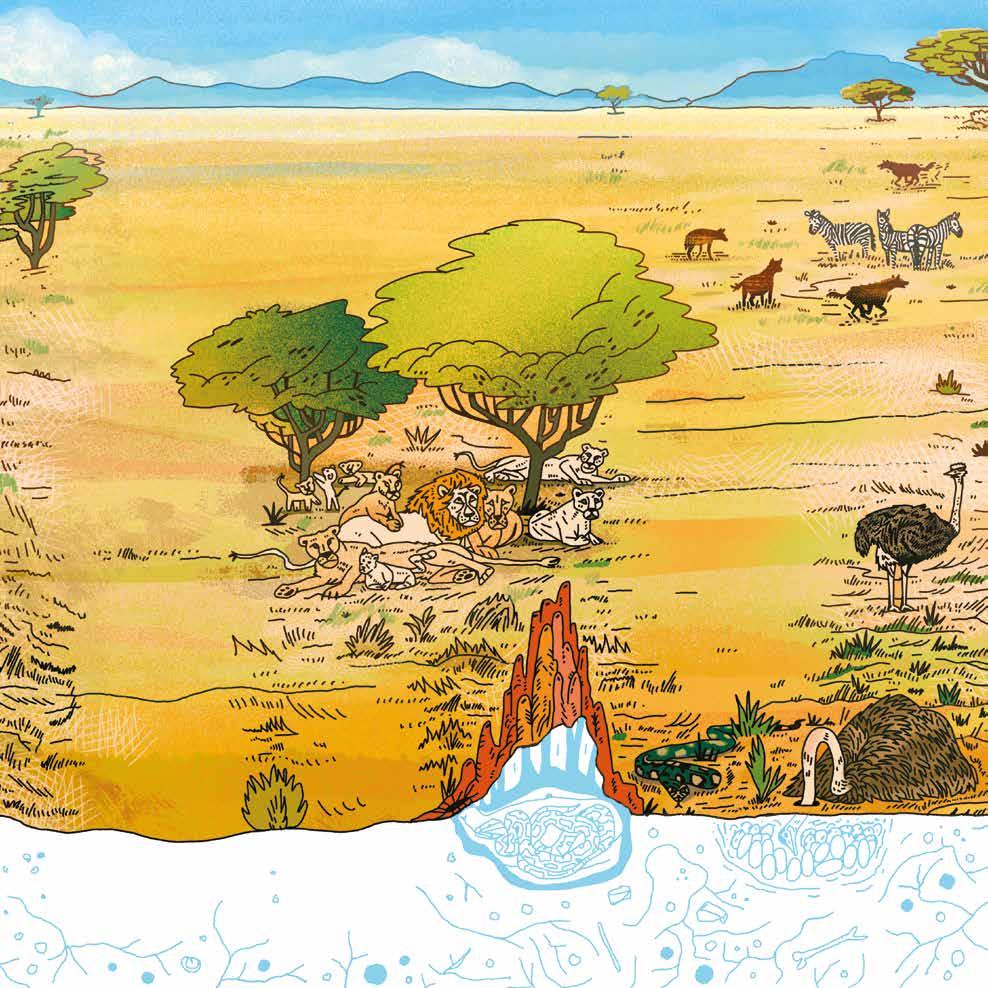

The red-billed oxpecker finds nest-building material in an unusual place. First, the bird hitches a ride on a zebra, pecking at its coat to eat ticks and flies. Then it lines its nest with the zebra’s hair.
A warthog stays one step ahead of a pack of hungry hyenas. At night, the warthog backs into its burrow, bottom first. In the morning, it charges out of its home at full speed, escaping the hyenas waiting in ambush.
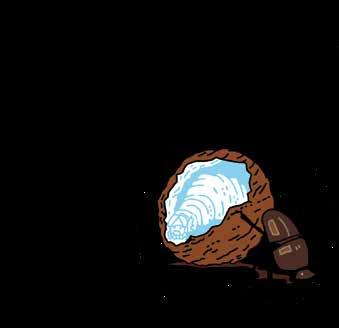
A female dung beetle has a clever way of looking after her young before they’re even born. She buries a ball of dung underground, then lays her eggs inside the dung. When the eggs hatch, the grubs, or larvae, will have plenty of dung to eat.
An aardvark quickly hides from a leopard on the prowl. The aardvark digs a deep hole in less than a minute with four sharp claws shaped like spades. Then it covers itself with soil.
Up to 400 sociable weaver birds live in a nest that looks like a shaggy haystack. Under the nest, there are separate entrances that lead to chambers, lined with soft leaves. To stop snakes from slithering up the trunk and attacking the nest, the birds weave sharp spikes made of straw near to each entrance.
How does an African trapdoor spider catch food from its home?
First, the African trapdoor spider makes a burrow. Then, it makes a trap door out of silk and soil. The spider shuts the door and waits inside. When an insect walks by, the spider senses the vibrations it makes. Quickly, the spider pops out of its burrow, grabs the insect, and drags it inside to eat it.
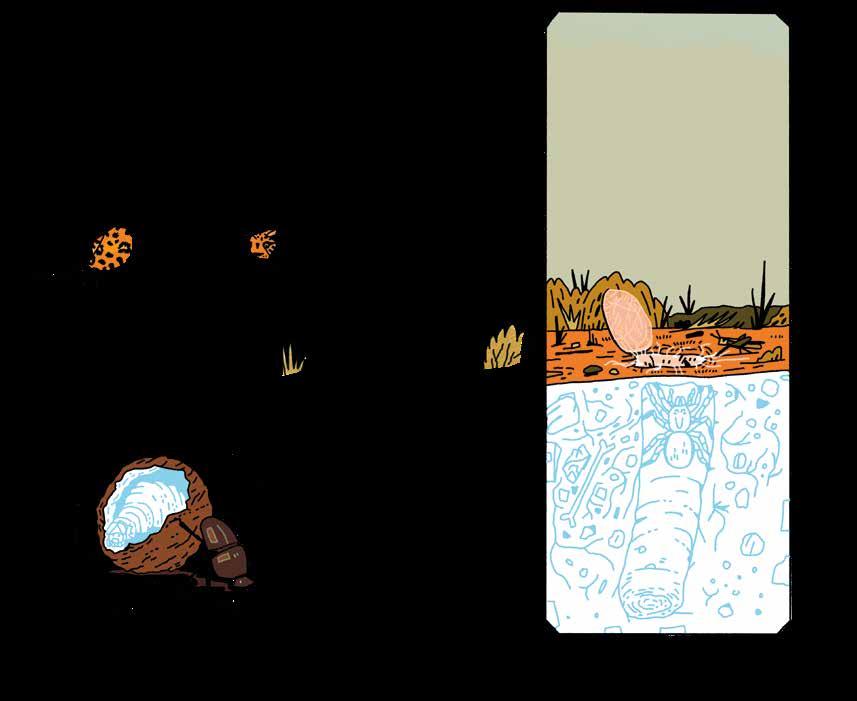
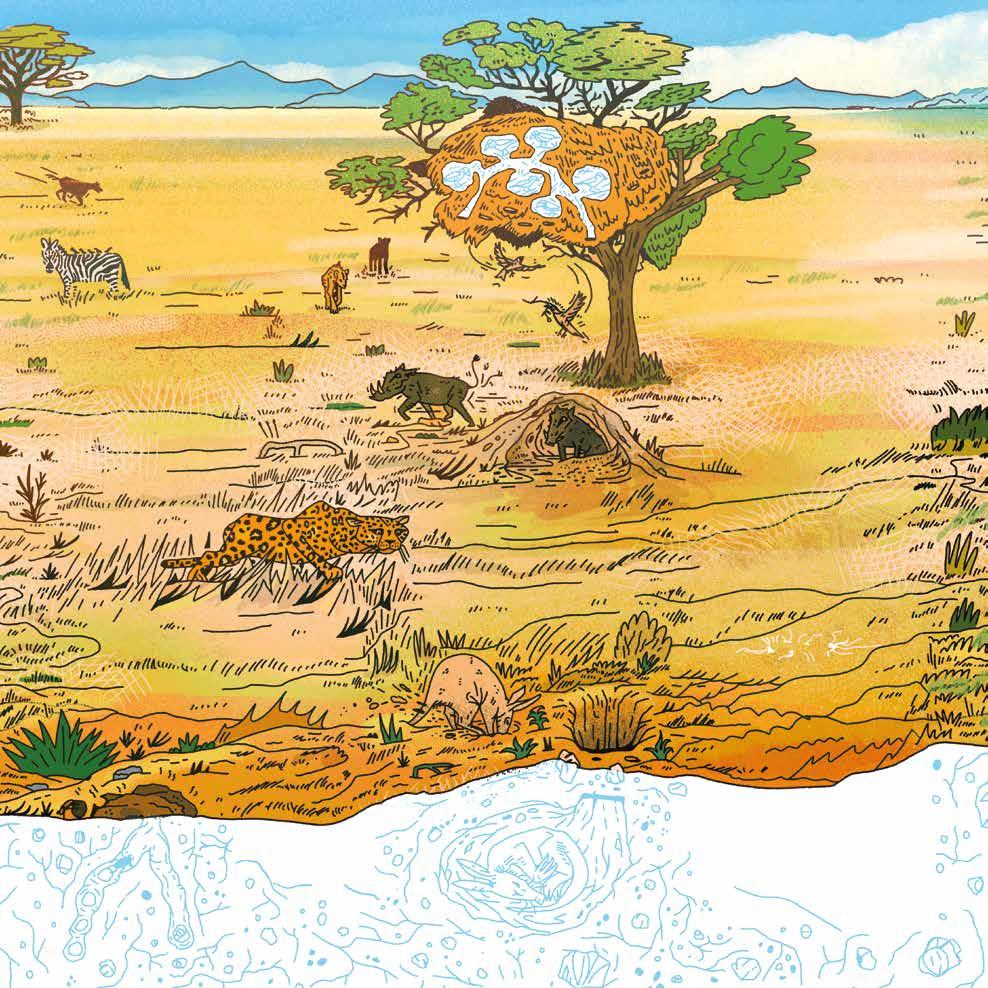

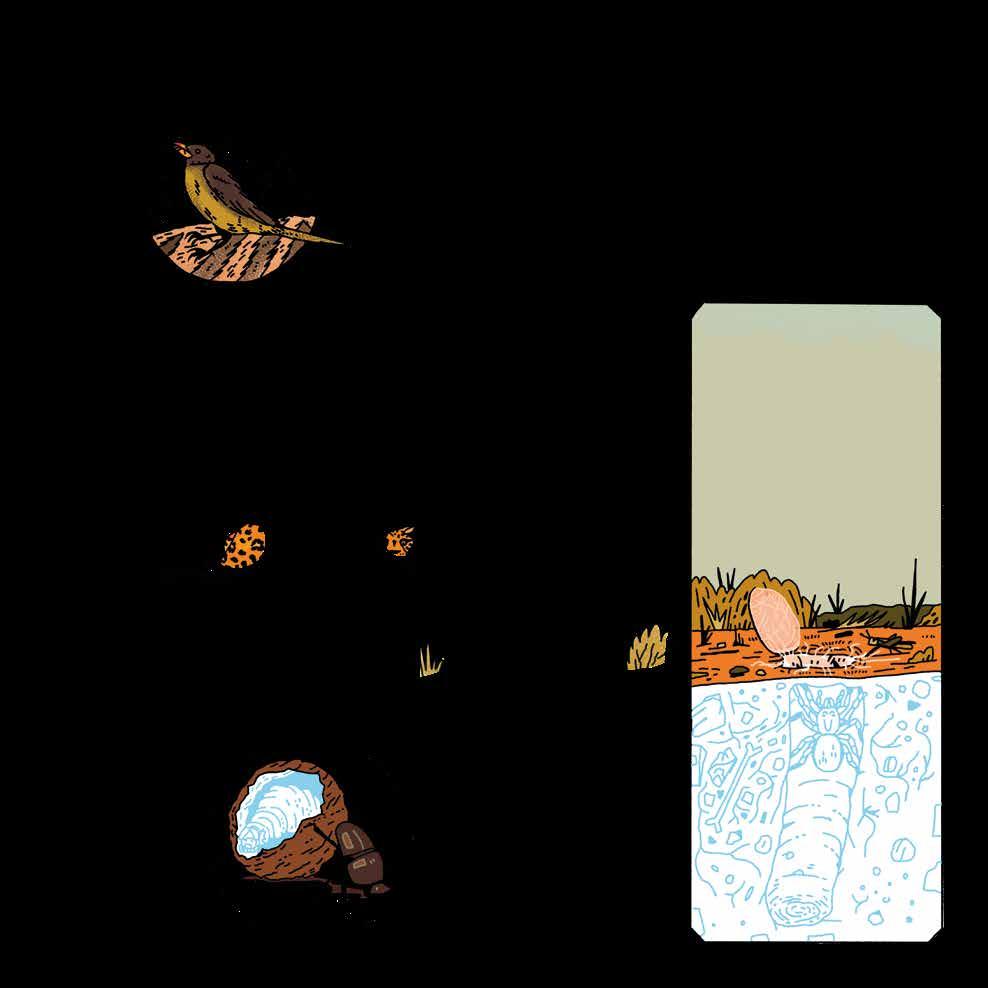

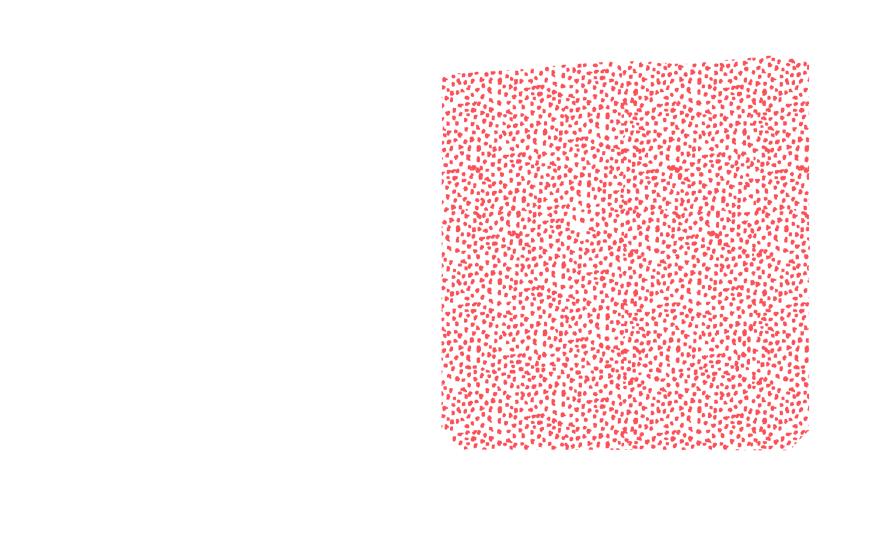
When is the best time to look for animal homes on a Northern European beach?
When the tide is in, the beach is covered in water, so it’s hard to see the animals below. But when the tide is out, all kinds of creatures and their homes appear on the sand.
As the waves rise and fall, the seashore changes. Seashore animals have adapted to their constantly changing home. To keep safe, some dig homes under the sand, while others hold on tight to the rocks so they aren’t washed away.
When the tide is out, squiggles of wet sand are left behind by lugworms. A lugworm makes a U-shaped burrow by swallowing sand, then pooing it out in coil shapes, called casts. Seabirds like to eat the casts as snacks.
Find out what happens to seashore animals and their homes as the tide goes in and out.
When the tide is out and the beach is dry, the limpet grips tightly to a rock. It uses a muscular suction foot covered in gluey slime. The limpet eats algae from the rock. When the tide is in, the limpet moves around and leaves a trail of slime behind. Often, the limpet follows this trail to return to its favorite spot.
On the beach, a masked crab makes a nest in the sand by digging backward. It uses its antennae like a snorkel to breathe. When the tide comes in and the waves are strong, the crab might be washed away to a different beach.
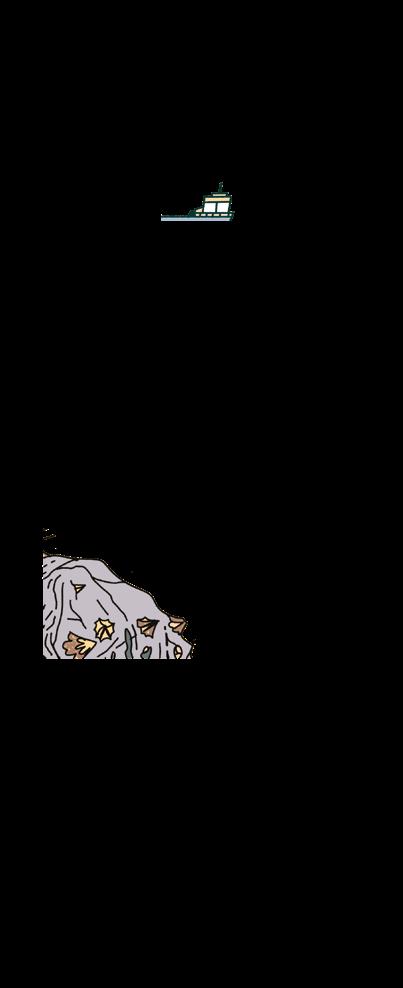
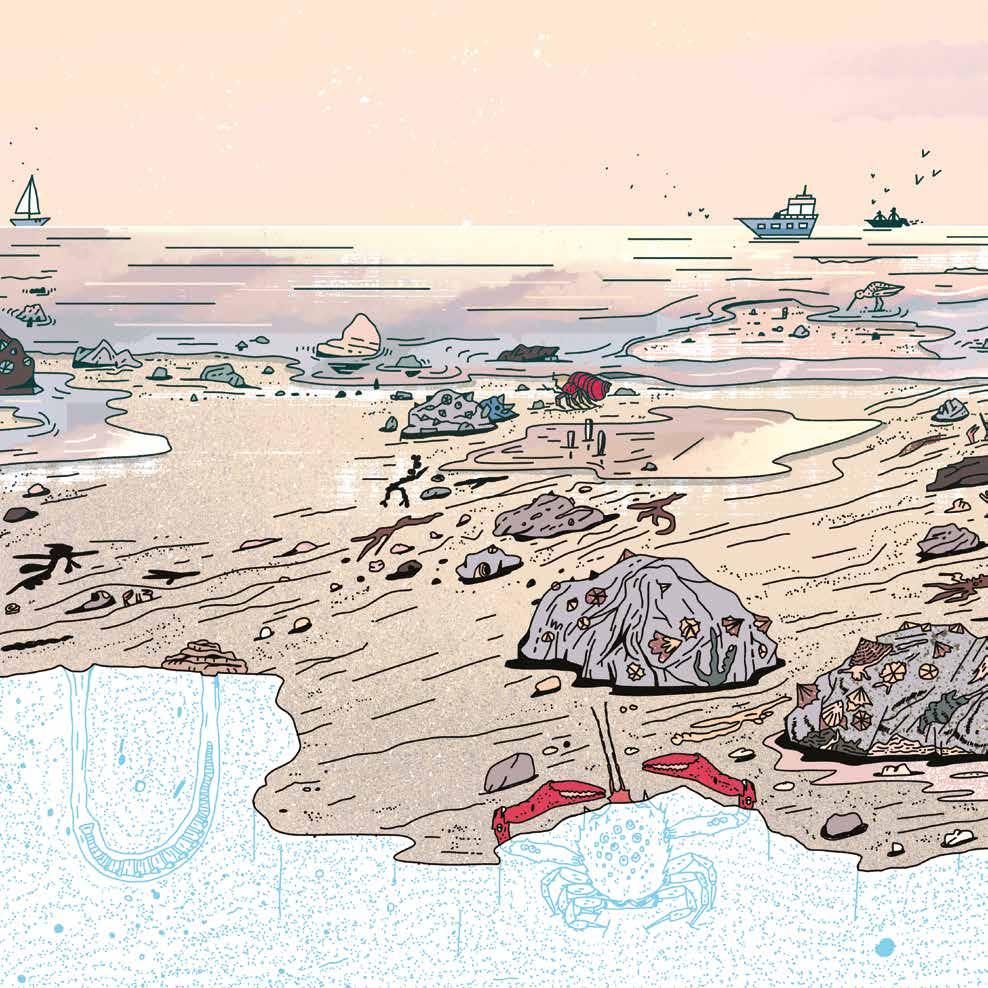
Can you spot the animals on this list? You’ll need the magic lens to find some of them!
lugworm
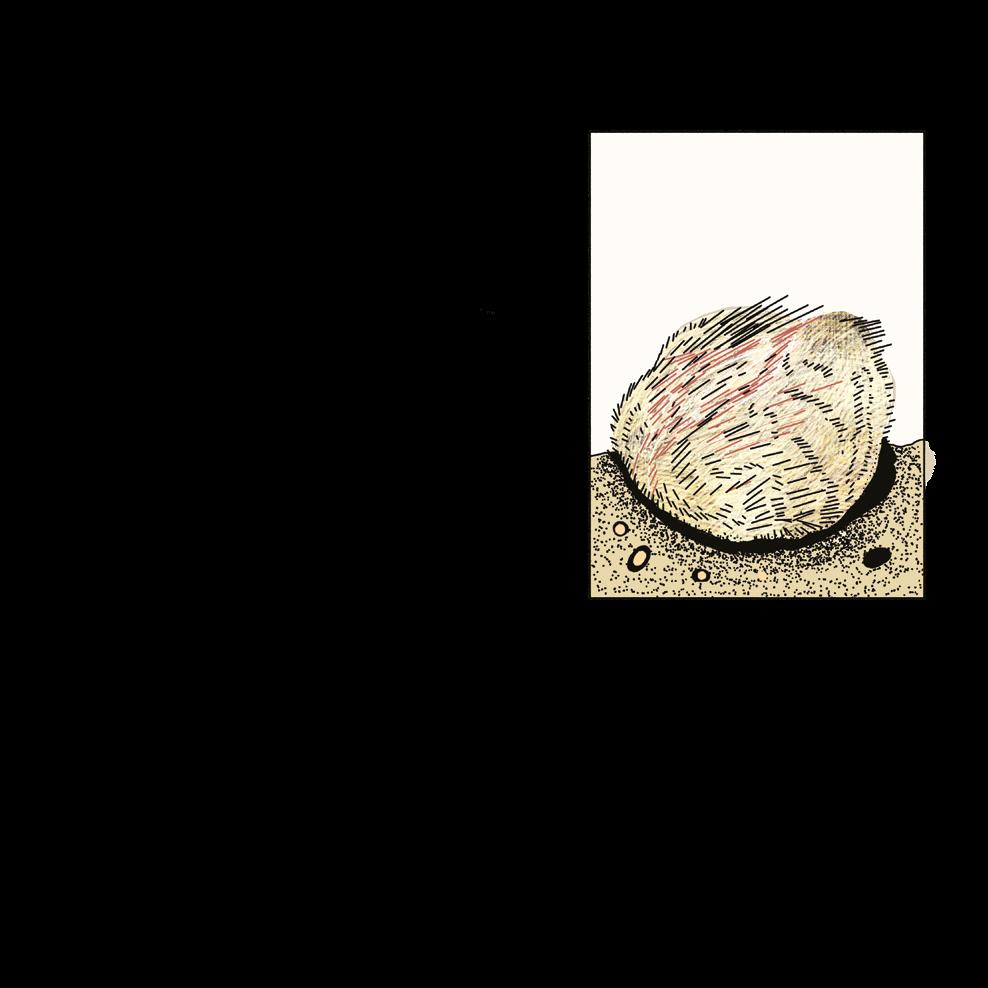
To make a burrow, a razor shell pushes and pulls with its powerful foot, drilling deep into the sand. It also squirts water downward to make the sand soft so it can dig more easily. When the tide comes in, the razor shell feeds by filtering microscopic plants, called plankton, from the seawater.
The sand mason worm builds a home from sand and bits of broken shell. It sticks them together with slime from its body. The worm builds a protective tube that sits half above and half below the sand. Above the sand, the worm’s home looks like a tiny sand tree, with branches that catch food.
Is a sea potato a vegetable? No—it’s a type of sea urchin! But it looks just like a potato with furry spines and tubelike feet. The sea potato lives in a burrow under the sand. It uses its feet to feed on dead animals and plants. When a sea potato dies, its empty shell might wash up on the beach.
How do beavers construct a home?
Beavers gnaw down trees and branches on the riverbank, then swim with the logs to the middle of the river, where they build their home. It is called a lodge.
First, the beavers prepare the construction site by building a high wall across the river. This is called a dam. It creates a safe pond in the river for their new home, which will have an underwater entrance and a dry room for all the family.
A family of up to eight beavers work together to build a dam and a lodge
Often, the beavers build at night.
Trip after trip, the beavers gather branches, stones, and mud from the banks of the river and the riverbed. They use this material to build a dam. Eventually, the dam shows above the water’s surface.
Explore the underwater world of a beavers’ lodge. LOOK INSIDE
Behind the dam, a deep pool forms. This is where the beavers will build their lodge on a private island. It will be far away from the riverbank and predators, such as bears, wolves, and coyotes.
A beaver gnaws the base of a tree with its sharp front teeth, called incisors. Once it has chewed away enough of the trunk, it lets the wind blow the top section over.
As the beaver swims, the river helps it to carry the heavy logs. A beaver spends lots of time in the water swimming and building. It has a thick, waterproof coat of fur that keeps it warm and dry.
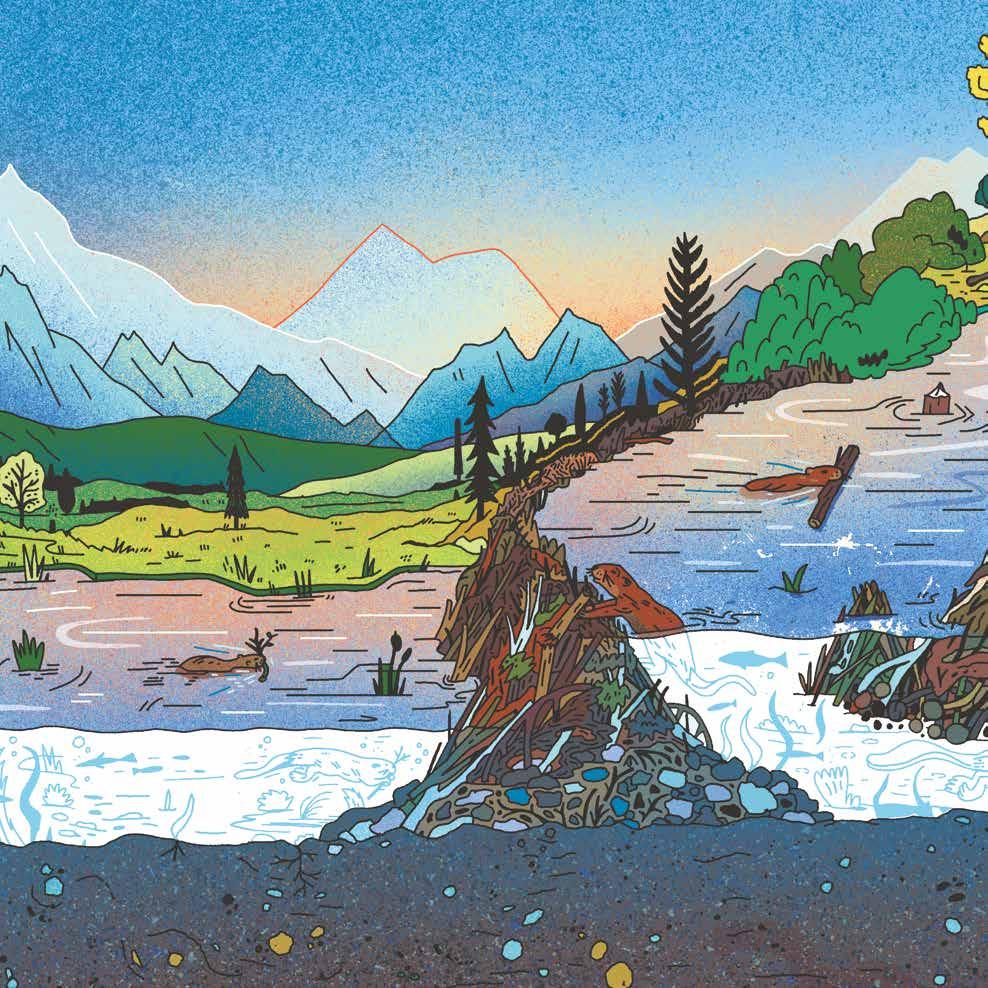
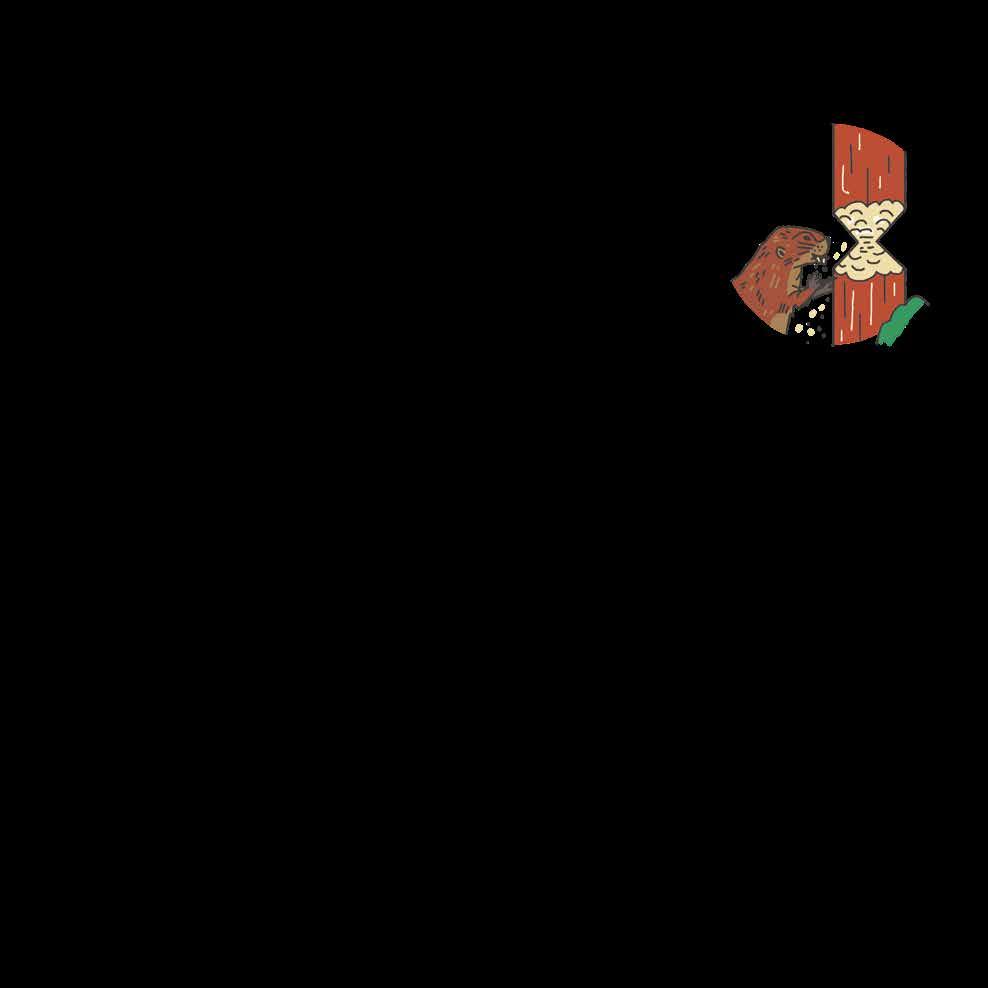
See-through eyelids help a beaver to see what it’s building underwater. It’s a bit like wearing goggles. A beaver can also close its nose and ears and stay underwater for up to 15 minutes.

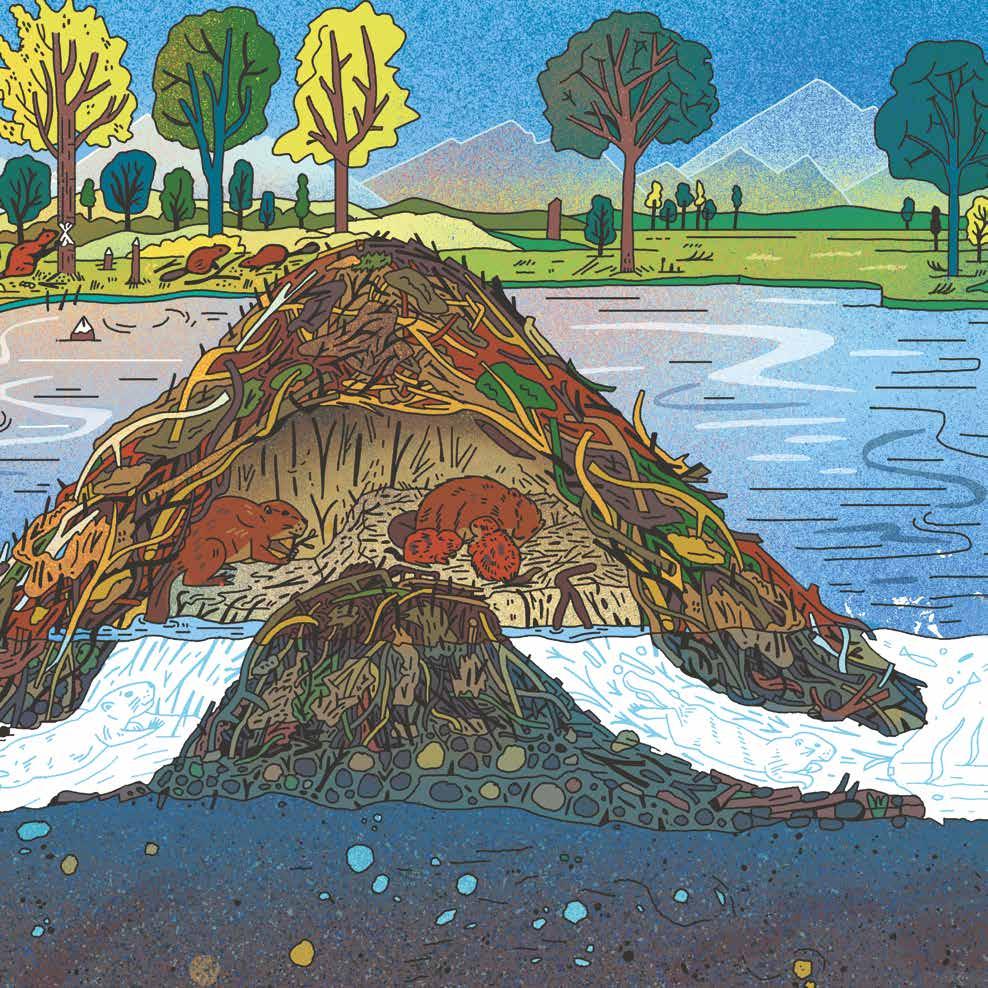
The beavers build an underwater entrance straight into the dry part of the lodge.
It’s warm in the living chamber, where there are places for eating and sleeping. The beavers eat from an underwater store of food they collect in the autumn.

FIND IT
Can you spot everything on this list? You’ll need the magic lens to find some of them!
lodge
dam
pool
incisors
waterproof coat
see-through eyelids
underwater entrance
living chamber
nursery webbed back feet
foundation
emergency exit
In the nursery, female beavers look after young beavers, called kits.
A beaver’s body is designed to swim fast. It can twist and turn in the water. A beaver also has a flat tail that works like a rudder and large webbed back feet that move up and down for speed.
The lodge is built on a dome-shaped foundation, so the lower parts of the lodge are wet and the higher part is dry.
There’s an emergency exit so the beavers can swim away from danger quickly. This exit is deep and usually doesn’t freeze in cold weather.
A goliath frog is as big as a pet cat!
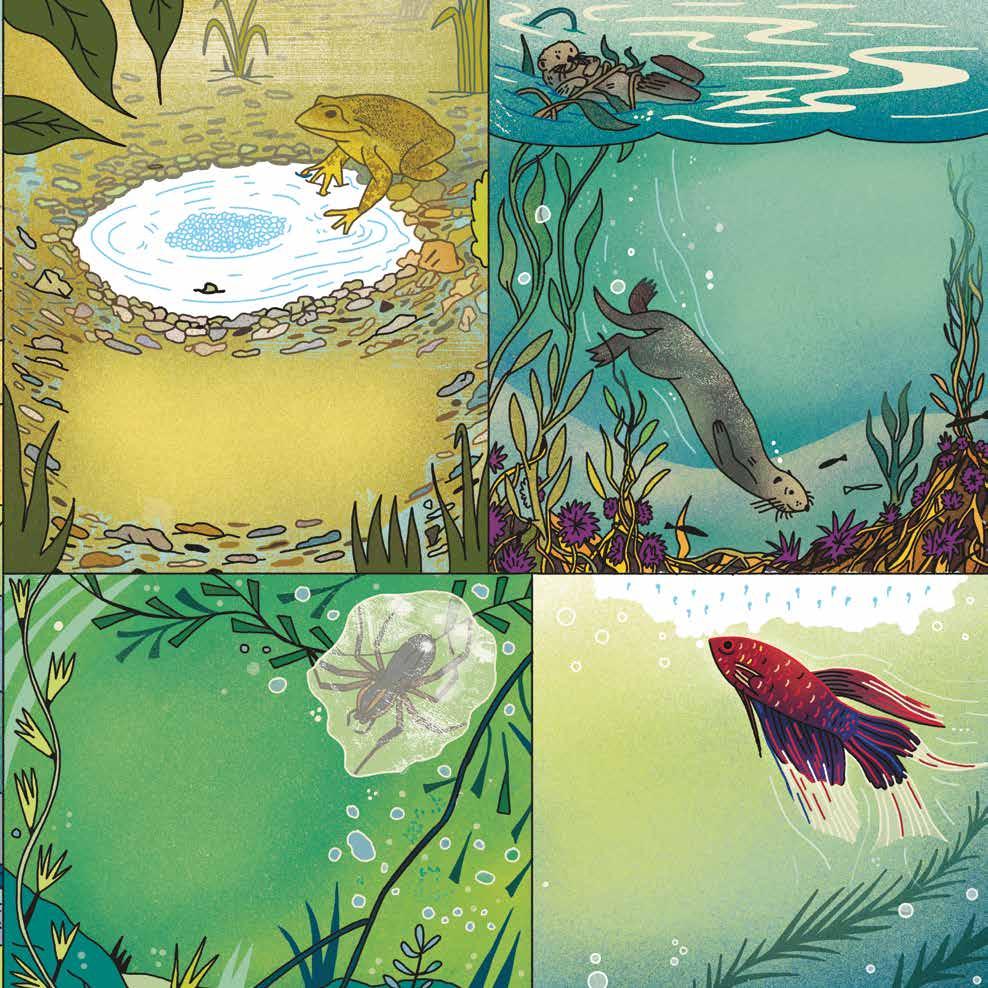
How does the biggest frog in the world build a nest?
On a riverbank in Western Africa, a male goliath frog builds a swimming pool to keep the female’s eggs safe. First, he finds a dip and clears it of leaves and rocks. Then he builds a stone wall all the way around the shallow water.
Who makes an inflatable home?
In a pond, a diving bell spider plunges under the water to build a web. It rises to the surface and traps shimmering air bubbles on the fine hairs of its body. Then the spider dives again and pushes the bubbles inside its web to make a bubble home where it can breathe. About once a day, the spider rises to collect more bubbles to replenish the air.
How does a mother sea otter keep her baby safe?
Sea otters make their homes in kelp forests on the Pacific coast. Here, kelp leaves grow up toward the water’s surface, while the sunlight shines into the clear water. Before a mother goes hunting for sea urchins, she ties her otter pup to a kelp leaf so it doesn’t float away.
Which fish makes a bubble nest?
A male Siamese fighting fish swims to the surface and takes big gulps of air, then noisily blows bubbles. He glues the bubbles together with spit. When the female lays her eggs, the male carefully catches them in his mouth and pops them inside the bubble nest. Safely inside the bubbles, they hatch and grow into fry, or baby fish.
More than 2,000 different kinds of animals can make their homes in one leafy oak tree. High and low, the animals build nests, look after babies, and eat. Some of the animals eat the tree’s leaves, bark, or acorns, while other animals eat each other!
A tree is a wonderful bubble of life called an ecosystem. This is a special place in nature, where plants and animals live together. An ecosystem connects with the environment, including the weather and the soil.
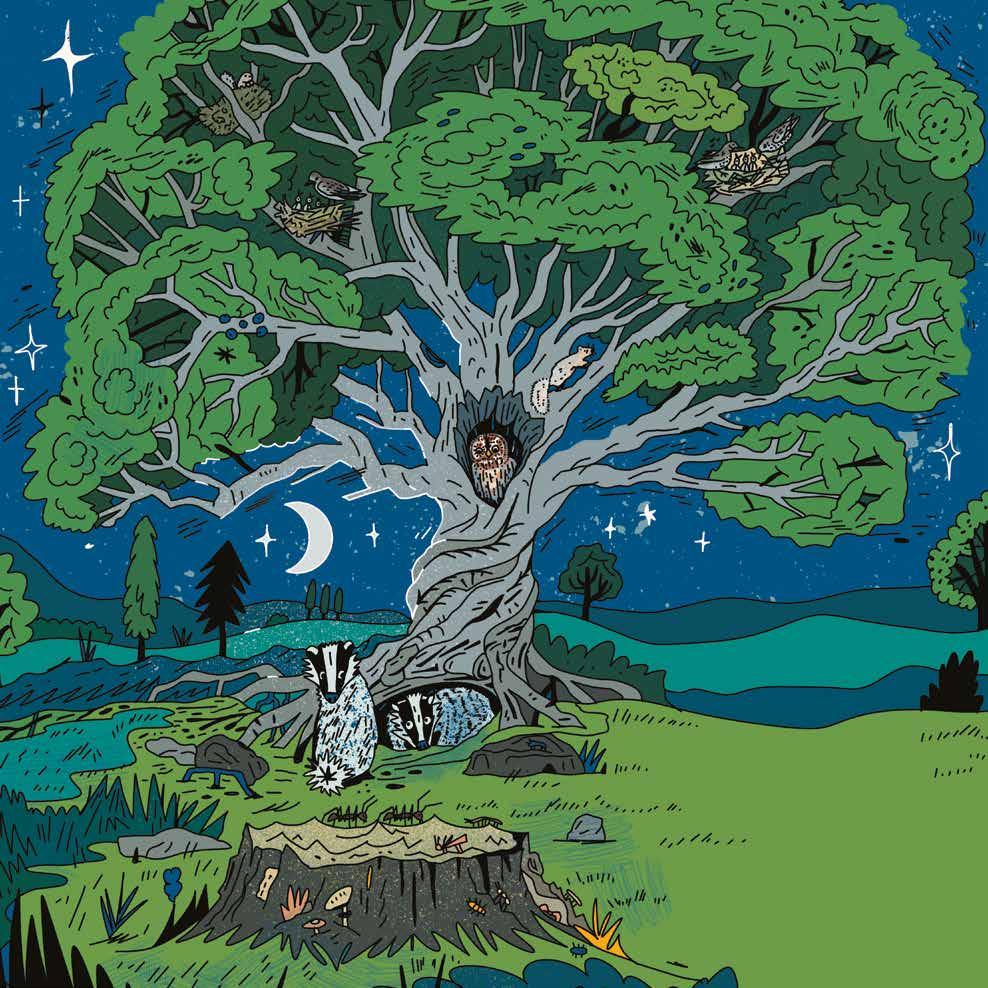

aardvarks 37
African rock pythons 36
African trapdoor spiders 37
Amazon rainforest 20–1 anacondas 21 Antarctica 9 ants 22–3, 30, 44
Arctic 10–11
Arctic foxes 10
Arctic ground squirrels 11
Arctic hares 10
Arizona desert 26–7 armadillos 32
Asian steppe eagles 33
B badgers 44 bald eagles 18 bats 21 bearded vultures 14 bears 8, 11, 12–13 beavers 40–1
bees 9, 15, 25 beetles 21, 25, 27, 37 birds 8, 9, 11, 14, 18–19, 20, 21, 24, 26, 27, 35, 36
black-footed ferrets 34, 35 bobcats 27 burrowing owls 27, 35 burrows 9, 10, 15, 21, 26, 27, 31, 32, 34–5, 37, 38, 39
C
caddis fly larvae 42 caiman 21
carpenter ants 44 cliff swallows 19 colonies 18, 22–3 coyotes 27, 34, 35 crabs 38, 42
D dens 8, 11, 12–13, 15, 27, 30
deserts 26–7, 30–1
diving bell spiders 43 dreys 24, 44 ducks 11
dung beetles 27, 37
E eagles 18, 21, 33
eider ducks 11 elephants 8 elf owls 26
emperor penguins 9 emu 32
F fennec foxes 30 fish 9, 42, 43 forests 20–1, 24–5 foxes 10, 30, 32 frogs 21, 43
G gannets 18
Gila monsters 26
Gila woodpeckers 9, 26
goliath frogs 43 gorillas 16–17
grassy plains 31, 32–3, 34–5, 36–7
Great desert skinks 31
grizzly bears 12–13
H hares 10
harpy eagles 21 harvest mice 33
hermit crabs 42
Himalayan bumblebees 15
Himalayan pit vipers 15
Himalayas 14–15 hives 9, 15, 25
howler monkeys 21 hummingbirds 8 hyenas 36, 37
I
ibex 14
Indian harvester ants 30
J
jaguars 20 jerboas 31
K kangaroos 30
L
leaf-rolling weevils 24 leafcutter ants 22–3
lemmings 10 limpets 38 lions 36 lizards 9
lodges 40–1 lugworms 38
M
marmots 15 masked crabs 38 mice 33
Mojave tortoises 31 monkeys 21 mountain gorillas 16–17 mountains 14–17
musk deer 15
N
nests: birds’ 8, 9, 11, 14, 18–19, 20, 24, 26, 32, 33, 37, 44
insects’ 22–3, 24, 25, 28–9, 30
mammals’ 10, 16, 17, 21, 24, 25, 33, 44
O oak trees 44 ostriches 36 owls 11, 26, 27, 35, 44
P pandas 25 parrotfish 42 penduline tits 19 peregrine falcons 19 polar bears 11 prairie dogs 34–5 prairie rattlesnakes 33
Q quail 26 R rabbits 9 razor shells 39 red-billed oxpeckers 37 red-eyed tree frogs 21 red oven birds 19 red pandas 15 red squirrels 24
S sand mason worms 39 savannas 32, 36–7 sea otters 43 sea potatoes 39 seashore 38–9 setts 44 shells 8, 42
Siamese fighting fish 43 snails 8 snakes 15, 21, 32, 33, 35, 36, 37 snow leopards 14 snowy owls 11 sociable weaver birds 37 spiders 21, 27, 37, 43 squirrels 24, 44 stag beetles 25
swallows 19 swiftlets 18
T tailorbirds 24 tarantulas 27 tawny owls 44 tent-making bats 21 termites 28–9 tortoises 31, 32 toucans 20 towns 34–5 trees 20, 24–5, 44 tundra 10–11
U underwater homes 42–3
W warthogs 37 weaver fish 9 wolverines 11 wombats 32 woodpeckers 9, 26
Z zebras 36–37
Blasco, Julio Antonio & Nassar, Daniel. Burrows, Nests & Lairs: Animal Architects (Laurence King Publishing, 2015)
Bone, Emily & Lechuga, Maribel. Look Inside Animal Homes (Usborne Publishing, 2018)
Hewitt, Sally.
Ladders: Animal Homes (Two-Can Publishing Ltd, 2000)
Howard, Jules & Letherland, Lucy. The Who, What, Why of Zoology: The Incredible Science of the Animal Kingdom (Quarto Publishing, 2003)
Packham, Chris & Cockroft, Jason. Amazing Animal Homes (Red Shed, 2018)
Stock, Charlotte.
Children’s Encyclopedia of Animals (Dorling Kindersley, 2009)
Taylor, Barbara.
3-D Close up Animal Homes (Wide Eyed Editions, 2023)
Wilkes, Angela. Animal Homes (Kingfisher Young Knowledge, 2003)
WEBSITES allaboutbirds.org amnh.org audubon.org bear.org birdfact.com faansiepeacock.com friresearch.ca gorillafund.org howstuffworks.com
kids.nationalgeographic.com naturespot.org nhm.ac.uk nhpbs.org
nps.gov polarbearsinternational.org sciencefocus.com
sdzwildlifeexplorers.org smithsonianmag.com
snowleopard.org
tswalu.com
